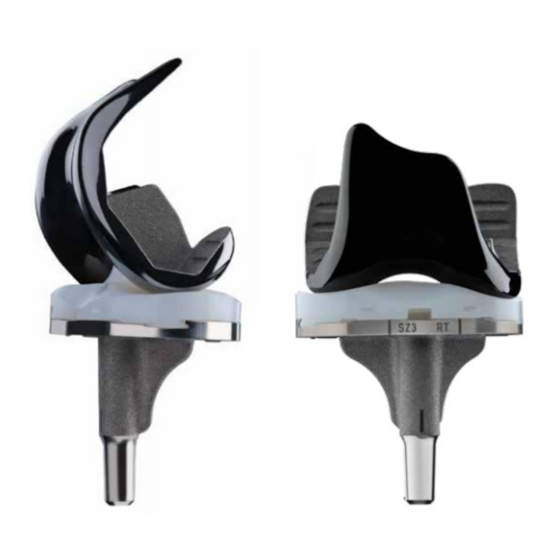
- Smith & Nephew Manuals
- Medical Equipment
- JOURNEY II BCS

Smith & Nephew JOURNEY II BCS Manual
- page of 48 Go / 48
Table of Contents
- Intended Use, Indications, Contraindications
- Indications for Use
- Design Rational/Surgical Planning Rational
- NAVIO Surgical System Overview
- Navio Instrument Trays
- Positioning the System
- System and Patient Setup
- Bone Tracking Hardware
- Surgical Preferences
- Registration
- Ligament Balancing
- Implant Planning
- Implant Planning - Soft Tissue Balancing
- Bone Cutting
- Trial Reduction
- Cement and Close
- Recovery Procedure Guidelines
- Manufacturer Contact Information
Advertisement
Quick Links
- 1 Intended Use, Indications, Contraindications
- 2 Design Rational/Surgical Planning Rational
- 3 Navio Surgical System Overview
- 4 Manufacturer Contact Information
- Download this manual
Related Manuals for Smith & Nephew JOURNEY II BCS

Summary of Contents for Smith & Nephew JOURNEY II BCS
- Page 1 Surgical Technique for use with the JOURNEY™ II BCS and JOURNEY™ II CR...
- Page 2 NAVIO™ Surgical System Surgical Technique for use with the JOURNEY™ II BCS and JOURNEY™ II CR Smith & Nephew 500081, Rev B Issue Date: 2016-11-16 The following technique is for informational and educational purposes only. It is not intended to serve as medical advice. It is the responsibility of treating physicians to determine and utilize the appropriate products and techniques according to their own clinical judgment for each of their patients.
- Page 3 Introduction This procedure guide provides an overview of the recommended surgical technique for using the NAVIO™ surgical system technology with the JOUR- NEY™ II CR (Cruciate Retaining) and JOURNEY™ II BCS (Bi-Cruciate Stabilized) Knee System. Smith & Nephew recommends that users review this guide prior to performing total knee arthroplasty utilizing the NAVIO system.
Page 4: Table Of Contents
Page 5: intended use, indications, contraindications, page 6: design rational/surgical planning rational, page 7: navio surgical system overview, page 8: navio instrument trays, page 9: positioning the system, page 10: system and patient setup.
- Page 11 System and Patient Setup Upon making the incision, carefully debride and inspect the joint. If any prominent spurs or osteophytes are present, especially in the area of the superior posterior femoral condyle, remove them with an osteotome or rongeur, as they could inhibit the leg motion.
Page 12: Bone Tracking Hardware
- Page 13 Bone Tracking Hardware Slide the tracker clamp (with the clamp opening • oriented towards the camera) over the two bone screws until the bottom of the clamp is within 1 cm of the patient’s skin, taking care not to place the clamp where it is touching the patient's skin.
Page 14: Surgical Preferences
- Page 15 Surgical Preferences Rotational References The NAVIO™ Total Knee application allows the user to choose landmark collection preferences on the femur and the tibia in order to define rotational references, from which the implant component placement plan and ligament balancing information is calculated.
- Page 16 Surgical Preferences Joint Line Selection Preference The joint line selection is an optional selection, which allows the user to choose a landmark point on the femur and/or tibia and offset a line perpendicular to the mechanical axis from that point to a chosen distance (Figure 15, 16). This reference line is then displayed during the implant planning stage, to guide the component placement.
Page 17: Registration
- Page 18 Registration Ankle Center Using the point probe, input the locations of the medial and lateral malleoli points by identifying the most prominent portion (Figure 20). Ensure that the point probe is visible throughout the point collection. If the probe is not visible, check that the tracking spheres on the point probe array are not overlapping (in front, or behind) the tracking spheres on the tibia tracker array.
- Page 19 Registration Most Posterior Lateral Point • This point is used in conjunction with the anterior notch point and the most posterior medial point for initial sizing of the implant component. Figure 23. Anterior Notch Point • This point is used as a reference during prosthesis planning to prevent notching of the implant component.
- Page 20 Registration Femoral Condyle Rotational References Based on surgeon preference, there are three options on which the femur rotational reference frame can be defined . These rotational references are used during Implant Planning (Section 6) for component placement onto the patient anatomy. It is important to understand how these collections are taken on the patient’s bony anatomy so that they may be referenced properly during planning.
- Page 21 Registration Posterior Condylar Axis Collection • The femur posterior condyles selection for defining the femur rotational reference, uses the most medial and lateral posterior condyles collections, and allows the user to dial in the medial-lateral axis angle with respect to the two points collected. Figure 28.
- Page 22 Registration Medial Plateau Point • Take the singular low-point of cartilage wear on the medial side of the tibial plateau. Lateral Plateau Point • Attempt to access the lateral side of the tibial Figure 31. condyle by flexing the leg and internally rotating the tibia and manually distracting the joint.
- Page 23 Registration AP Axis Collection • While all of the other collections listed above are singular points referencing the tip of the point probe, this collection will reference the axis of the point probe. If the AP axis is selected for rotational reference collection, using the length of the pointer probe, collect the AP axis on the tibia, normal to the transepicondylar axis.
- Page 24 Registration Tibia Joint Line Reference [Optional- Based on Surgeon Preference] The tibia joint line reference allows the user to pick a landmark point on the bone surface and offset a line perpendicular to the mechanical axis from that point. Figure 37. Tibial Condyle Surface Mapping The Tibia Free Collection stage (Figure 38) offers a visualization of the tibial mechanical and rotational...
Page 25: Ligament Balancing
Page 26: implant planning.
- Page 27 Implant Planning 1. Using the cross section mode, in the transverse and coronal view, confirm that the component size provides adequate coverage on the digitized femur bone surface (Figure 41). Drag vertically on this view screen to visualize the superior-most part of the implant component on the bone (Figure 42).
- Page 28 Implant Planning 5. The implant components for JOURNEY II knee system are posterior referenced. Therefore, in order to have greater resection on the posterior bone, and to increase posterior gap, the component may be downsized, without any change to the anterior transition of the component on to the bone.
- Page 29 Implant Planning 1. Confirm the implant size using the transverse viewscreen (bottom left) and the tibia size up/ down button arrows in the right-hand control panel on the right side of the screen underneath the Tibia Size button. 2. Confirm the posterior slope, utilizing the sagittal view (upper right), NAVIO software will display the posterior slope within this viewscreen, which reflects the slope of the tibial implant component...
- Page 30 Implant Planning Button Mapping Femur While the NAVIO™ System for Total Knee Arthroplasty User’s Manual details each button on this screen, the following five buttons (Figure 46) are particularly critical to understand. - The Checkpoint Verification button is used to manually force a check of the checkpoints in the femur and tibia.
- Page 31 Implant Planning Button Mapping Tibia While the NAVIO™ System for Total Knee Arthroplasty User’s Manual details each button on this screen, the following five buttons (Figure 47) are particularly critical to understand. - The Checkpoint Verification button is used to manually force a check of the safety checkpoints in the femur and tibia.
Page 32: Implant Planning - Soft Tissue Balancing
- Page 33 Implant Planning - Soft Tissue Balancing Gap Balancing The goal of this stage is to have balanced extension and flexion gaps, with no overlap in either condyle, (i.e, medial or lateral). The extension gap will likely look unbalanced when comparing the medial and lateral space if no ligament release has been performed for a deformed knee.
- Page 34 Implant Planning - Soft Tissue Balancing Ligament Balancing Manipulations SCENARIO MANIPULATION Balance is tight Move tibial component inferior and/or in extension reduce thickness and flexion Balance Move tibial component superior and/or is loose in increase poly thickness extension and flexion Balance is tight Move femoral component superior.
- Page 35 Implant Planning - Soft Tissue Balancing Ligament Balancing Manipulations SCENARIO MANIPULATION Balance is loose in the Internally rotate the femur implant to medial compartment in balance gap in the medial and lateral flexion compartments Balance is tight in the Externally rotate the femur implant medial compartment in to balance gap in medial and lateral flexion...
Page 36: Bone Cutting
- Page 37 Bone Cutting Cut Guide Placement Prior to preparation of the locking features for cut guides on to the patient bone surface using the NAVIO™ handpiece in speed control, the user is presented with a cut guide placement screen, where the goal is to size the appropriate cut guide for the operation.
- Page 38 Bone Cutting The user has the ability to move the cut guide anterior and posterior, as well as rotate it in the cut plane. Confirm that the cut slot portion of the guide is not impinging on the bone surface by referencing the cross section view, as well as the 3D view (See Figure 58).
- Page 39 Bone Cutting Screen Overview Figure 60 shows a typical cutting screen with the following icons/buttons called out: - Checkpoint Verification button, used to activate a confirmation of the safety checkpoints on femur and tibia. - Change Bur button, used when the user switches bur size to tell the system about the change.
- Page 40 Bone Cutting Bone Preparation Warning: The NAVIO™ system does not prohibit cutting of soft tissue, which may be in the surgical area. Always use retractors to protect ligaments and other capsular structures. Use steady movement to minimize potential for ligament damage. Warning: NAVIO control modes do not establish “no-cut”...
- Page 41 Bone Cutting Cut Femur The handpiece is used to prepare four cylindrical features in the patient’s bone in order to lock the NAVIO™ femur cut guide onto the bone surface. 1. Align the handpiece tool, under speed control on the cut zone (areas color-coded purple, blue and green on the monitor), by utilizing the cross-hair visualization, and the tool’s eye view.
- Page 42 Bone Cutting 10. Ensure that the dial on the block is set to the zero mark, and tighten the dial using the Smith & Nephew JOURNEY 3.5 mm hex driver. Using the recommended saw, prepare the five planar femur cuts, as recommended by the implant manufacturer in the JOURNEY II Total knee surgical technique.
- Page 43 Bone Cutting Using the handpiece, prepare four features in the patient’s bone in order to lock the NAVIO™ tibia cut guide onto the bone surface. Make sure to uncover the tibia tracker array if it was covered for protection while burring the femur. 1.
Page 44: Trial Reduction
Page 45: cement and close, page 46: recovery procedure guidelines, page 47: notes, page 48: manufacturer contact information, this manual is also suitable for:, rename the bookmark, delete bookmark, delete from my manuals, upload manual.
- Robotic Assisted UKA
- Robotic Assisted TKA
- Robotic Assisted Revision Knee
- Computer Guided THA
- Data Visualization
- Partial Knee
- Primary Knee
- Revision Knee
- Oxinium™ in Knee
- VISIONAIRE™ Technology
- Primary Hip
- Revision Hip
- Oxinium™ in Hip
- PICO™
JOURNEY UNI Surgical Animation
For orthopaedic surgeons seeking treatment solutions beyond traditional knee replacements, the JOURNEY™ UNI has been engineered to empower patients with a renewed right to an active lifestyle by breaking through traditional knee replacement barriers and delivers Function, Motion and Durability through PHYSIOLOGICAL MATCHING Technology.
Access Restricted
You must provide the password to continue.

How it works
For Business
Join Mind Tools
Article • 6 min read
The Journey Technique
Remembering long lists.
By the Mind Tools Content Team
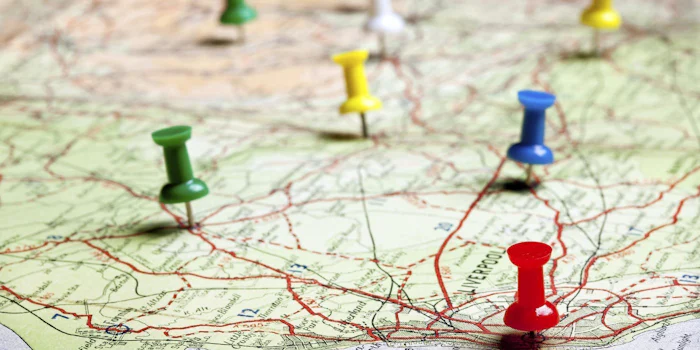
If you forgot something on your shopping list, chances are you wouldn't be very surprised. But if you forgot the route to the store? Now that would be a shock!
It's because we expect to remember journeys. So why not use that ability to help with other, harder types of learning?
This article explains how to do just that, using a memory method called the Journey Technique. It's a powerful way to learn lists confidently and effectively.
What Is the Journey Technique?
The Journey Technique is an ancient memory method that lets you store new information within familiar mental journeys, allowing you to navigate it with ease.
You could use your journey to work, for example; the route you take to visit your parents; or a tour around a regular holiday destination.
It's a great way to learn lists, because each journey gives a clear order to all the information held within it.
How to Use the Journey Technique
To use the Journey Technique most effectively, it's best to prepare a journey beforehand. This ensures that the landmarks are clear in your mind before you use them to "store" new information.
So first pick a journey that you're very familiar with. Spend a few moments imagining yourself traveling along the journey.
Next, choose landmarks or points of interest along the way. When you've selected approximately ten, write them down – and check that you can remember them in order. You'll need to keep this sequence the same every time you use this particular journey.
When you're ready to remember a list, pick an image to represent each item. With things that you can already "see," such as objects or people, the images will likely be straightforward. However, it's a good idea to exaggerate them, to make them even more memorable.
With more abstract information, such as discussion points or business concepts, you may need to invent "image clues" to represent them in your journey.
If you're struggling to come up with an image for an abstract concept, imagine you're adding a picture to a presentation slide. What sort of illustration would you select to get your point across?
Finally, "position" your chosen images at the landmarks on your journey. You can have fun in your imagination as you create weird and wonderful scenes all along your route.
An Example of the Journey Technique
Let's say you needed to remember a shopping list:
coffee, salad, peas, bread, fish, chicken, pork chops, soup, fruit, bathtub cleaner
Using your regular journey to the store, you might pick the following stopping-points:
- The doormat by your front door.
- The rose bush in your front garden.
- Your driveway.
- The junction at the end of your road.
- A bridge over the highway.
- Traffic signals.
- The local fuel station.
- A large office building.
- A playground by the road.
- The supermarket parking lot.
You would then visualize one item at each of those points, in sequence. The journey might look like this:
- On the doormat, coffee beans are piled high.
- Under the rose bush, a rabbit is munching crunchy salad leaves.
- On your driveway, someone has spilled thousands of bright green peas.
- At the junction there's a signpost made of bread.
- From the bridge, freshly caught fish are hanging above the traffic.
- At the traffic signals there are chicken breasts where the lights should be.
- Outside the fuel station, a pig is doing karate chops (pork chops!).
- In front of the office building there's a deep river of tomato soup.
- In the playground, children are jumping from the swing set to pull fruit from a tree.
- In the supermarket parking lot, a dirty bathtub (in need of cleaner) is blocking your favorite spot.
When the time comes to recall the list, you simply retrace the journey in your "mind's eye." At each stopping-point, you should find an unforgettable image of something to buy.
You can use the Journey Technique in many different workplace situations.
A journey could hold all the key points for a presentation, for example.
If you're negotiating, why not use a journey to memorize your most persuasive pieces of evidence?
And it might be useful to learn the phases of a project this way, and then add in extra details – so that the information you need is always at your fingertips.
Making the Most of the Journey Technique
This is a very flexible memory system. To learn longer lists, simply create longer journeys. To remember a short list, only use part of the route!
Another advantage of this technique is that you can use it to work both backward and forward, and start anywhere within the route to retrieve information.
You can also combine this technique with other mnemonics. This can be done either by building complex images at particular stops on a journey, or by linking to other mnemonics at each one. You could even use some of the landmarks as starting-points for entirely new journeys.
The Journey Technique Infographic
See our Journey Technique infographic .
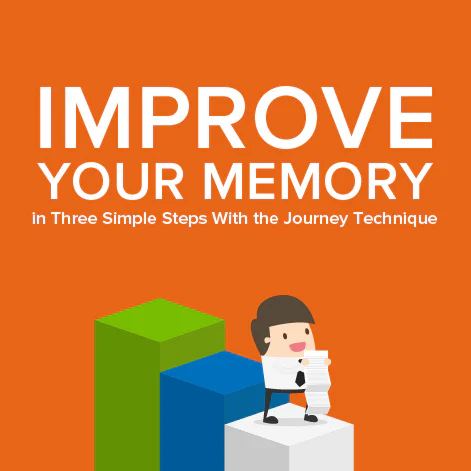
The Journey Technique is a way of remembering lists by visualizing images at points along a familiar journey. It involves three steps:
- Choose a journey you know well and highlight memorable landmarks or stopping-points along the way.
- Create images to represent each item on a list that you want to remember.
- Visualize those images arranged, in sequence, at the landmarks you've chosen on your journey.
Be as imaginative as you can to create a richly memorable map. And all the images should still be there when you make the journey again in your "mind's eye."
You've accessed 1 of your 2 free resources.
Get unlimited access
Discover more content
Memory improvement techniques – start here.
Boosting Your Powers of Recall With Mnemonics, Senses and Emotions
The Major System
Remembering Very Long Numbers
Add comment
Comments (0)
Be the first to comment!

Team Management
Learn the key aspects of managing a team, from building and developing your team, to working with different types of teams, and troubleshooting common problems.
Sign-up to our newsletter
Subscribing to the Mind Tools newsletter will keep you up-to-date with our latest updates and newest resources.
Subscribe now
Business Skills
Personal Development
Leadership and Management
Member Extras
Most Popular
Newest Releases

SWOT Analysis

How to Build a Strong Culture in a Distributed Team
Mind Tools Store
About Mind Tools Content
Discover something new today
Top tips for delegating.
Delegate work to your team members effectively with these top tips
Ten Dos and Don'ts of Change Conversations
Tips for tackling discussions about change
How Emotionally Intelligent Are You?
Boosting Your People Skills
Self-Assessment
What's Your Leadership Style?
Learn About the Strengths and Weaknesses of the Way You Like to Lead
Recommended for you
Eco-leadership.
An Overview of Simon Western's Work on This Emerging Leadership Approach
Business Operations and Process Management
Strategy Tools
Customer Service
Business Ethics and Values
Handling Information and Data
Project Management
Knowledge Management
Self-Development and Goal Setting
Time Management
Presentation Skills
Learning Skills
Career Skills
Communication Skills
Negotiation, Persuasion and Influence
Working With Others
Difficult Conversations
Creativity Tools
Self-Management
Work-Life Balance
Stress Management and Wellbeing
Coaching and Mentoring
Change Management
Managing Conflict
Delegation and Empowerment
Performance Management
Leadership Skills
Developing Your Team
Talent Management
Problem Solving
Decision Making
Member Podcast
- Search the site

The Journey Method: Your New Secret Weapon for Remembering
Anthony Metivier | August 27, 2023 | Memory

It’s a great tool.
Once you understand how it works, you’ll enjoy legendary memory skills.
This is the technique people used to memorize entire books when they could not carry them on their backs.
So if you’re studying for an exam, learning a language or just want to stop forgetting things , this tutorial is for you.
Let’s get started.
What Is The Journey Method?
Put simply, it’s a means of associating information along a walk that you remember well.
It’s powerful because the mind works like this on autopilot.
Think about the last time you moved.
Did you have to memorize the journey from your bedroom to the kitchen? Probably not. Your brain absorbed the path easily and naturally.
Now extend this fact to a walk through your neighborhood.
And not passively.
Think about that walk in as much detail as you can muster.
If you think about it, you can probably recall all the major intersections, as well as many minor ones.
You can also probably think of a few traffic signs, mail boxes, fire hydrants and other items.
These are what we sometimes call loci or “ memory spaces .” The Journey Method uses such features of a walk you can take with your mind.
On, beside or interwoven with these spaces, you place associations that help you recall information. Like I discuss in this video tutorial:
A Brief History of Journey Systems
It’s not entirely clear when people first started using journeys to help them remember things better.
As Lynne Kelly has demonstrated in The Memory Code , this practice is prehistoric. One tradition we’ve come to know about in some detail is the use of Songlines. These journeys were often combined with physical objects that helped people remember. Please listen to Tyson Yunkaporta for more detail on how this works.
In the Greek tradition, we find a focus on using buildings for journeys. This is what is most often called the Memory Palace technique. Sometimes it is called either the method of loci or the Roman Room method.
Some people consider using buildings a subset of the Journey Method. Others simply divide the two.
- If the journey is outside, they call it the Journey Method
- If the journey is inside, they call it the Memory Palace
Either way, you’ll find the notion of moving from one “memory space” to another throughout history. It’s in the teachings of everyone from Aristotle to Giordano Bruno , and Thomas Aquinas and Dominic O’Brien .
In fact, the only person notorious for not talking about it much, if at all, is Harry Loryane . However, if you’ve ever seen the videos where he recalls the names of people in an audience, one thing is pretty obvious. He recalls them in order, literally following a “journey” through the audience.

When memory experts name everyone in an audience, they are implicitly using the Journey method.
How To Use The Journey Technique
There are a number of ways to use the technique, but they all boil down to a few fundamentals.
Let’s dive into some of these fundamentals. That way you can avoid running into issues and use it in an optimal way without any headaches.
After all, it’s a better memory you want, not the hassle of something difficult to learn and use.
One: Develop The Journey Before You Start Using It
One problem people face when taking up this mnemonic device is a lack of preparation.
That’s a shame, because it’s really easy to draw your journey, literally mapping it out. I suggest using pen and paper to keep it simple and fun.
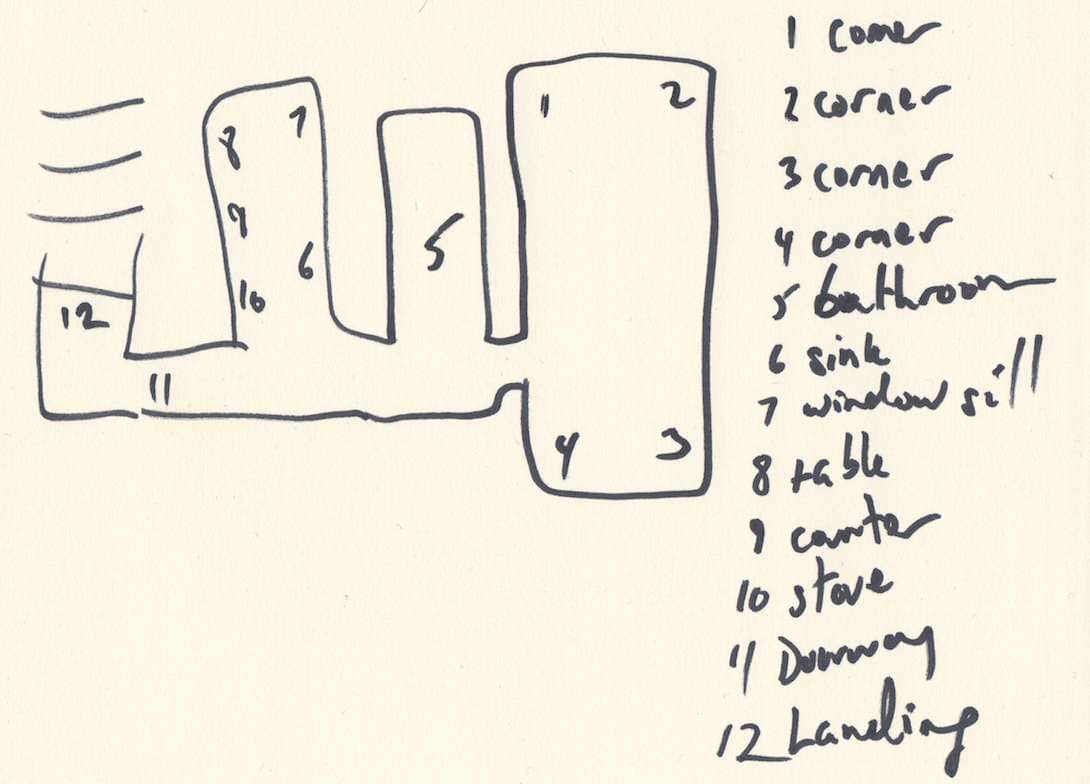
For one thing, keeping the journey simple reduces the cognitive load of using this technique. It also helps you avoid:
- Running into a dead end
- Crossing your own path
- Needing to memorize the journey itself, which shouldn’t be necessary with proper planning
It also helps you develop the habit and serves as a “haptic” exercise that makes the process physical. We know from recent scientific studies that these elements are incredibly important.
In this study, students who physically walked the journey, for example, recalled the names of butterflies with incredible ease. They scored just a bit better than those who used a mental Memory Palace without a physical component.
To see me draw a journey while I’m making the experience physical, here’s a video discussion about the tactical benefits of preparing your journeys in advance:
Two: Organize Your Information In Memorable Ways
Once you’ve got a few journeys mapped out, you can start thinking about how you will place information in them. You can arrange information:
- Alphabetically
- Numerically
- Thematically
- Historically
And that’s just for starters.
Alphabetical arrangements tend to work best for me.
For example, when learning a language , it’s easy to gather new words alphabetically. It enables another technique I teach in the Magnetic Memory Method Masterclass that involves using “Bridging Figures.”
Imagine you have several words to learn that start with the letter ‘A’ in Spanish:

I might choose an application like Adams National Historical Park to create my journey for these ‘A’ words. Here’s an example of how to assign different “memory spaces” or loci along a journey:

When using the Journey Method, you can use the outer walls of buildings and paths with great ease. Just take a moment to work out the best possible path first.
On the first station, I would place an association for “agradable.” The next station would receive an association for “alegre” and so on.
What should your associations be like?
You’ll probably benefit most from also thinking alphabetically.
Personally, I would follow someone like Abraham Lincoln along the journey. He would be a teacher assigning a nice person a grade on station one, selling his leg on station two, etc.
Coming up with lots of associations is a skill of its own. You’ll want to learn some of the variations on the pegword method to rapidly accelerate your abilities in this area. These visualization exercises will be useful too.
Three: Use Patterns To Form Long Term Memories
As fun as journey training can be, it’s not just about laying down mental imagery . You also need to revisit the journeys in a strategy manner.
This is because some amount of repetition is always needed for learning. Some people balk at this requirement, but here’s a question for you:
If you don’t want to repeat it, why bother learning it?
To repeat the journey in the most effective ways, you’ll want to follow some patterns based on memory science. These will harness what are known as:
- Primacy Effect
- Recency Effect
- Serial-Position Effect
All of these patterns are covered in detail in my free course. You’ll find them in lesson four. Interested?

Can You Reuse Journeys?
Many people ask this question.
The answer is “yes,” but most people don’t. If they do, they let the information they’ve placed along their journeys fade first.
There are a few nuances to consider before giving this technique a try. One of the issues you might encounter is called The Ugly Sister Effect .
Personally, I rarely reuse mine – except in the context of language learning. See the language learning section for more on how that works.
Applications For The Journey Method
A lot of people mistakenly believe that journey systems are useful for memorizing lists only.
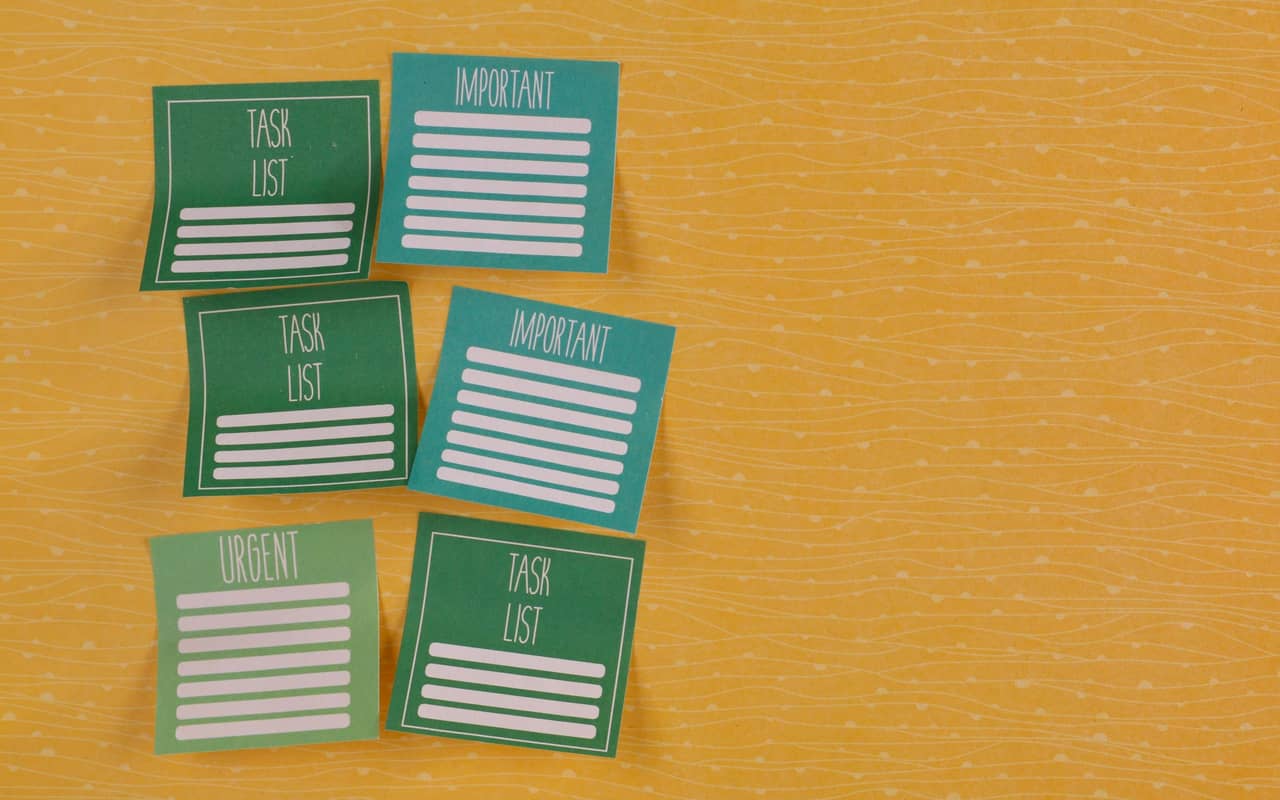
That’s simply not true.
Or better said, everything I’ve ever wanted to memorize could be organized into a list. But that doesn’t mean I had to recall the information in any particular order.
Language Learning
For example, in language learning, the whole point is to simply understand and be able to use words and phrases. The fact that they were instilled into long term memory in the form of lists poses no problem at all.
I suggest that you develop 26 journeys, one per letter of the alphabet. Then fill each journey with 10 words per letter. This will give you 260 words.
Next, add a phrase to each word. Since you’ve established the journey, this is a fun and easy way to reuse it. You’ll also wind up adding many more words than 260 as each phrase will contain words you don’t already know.
Technically, a speech is just a list of words delivered in a row. That’s certainly how I treated this TEDx Talk:
Here’s an artist’s rendition of the journey I assigned and then used to memorize this talk based on a familiar location in Kelvin Grove, Australia:
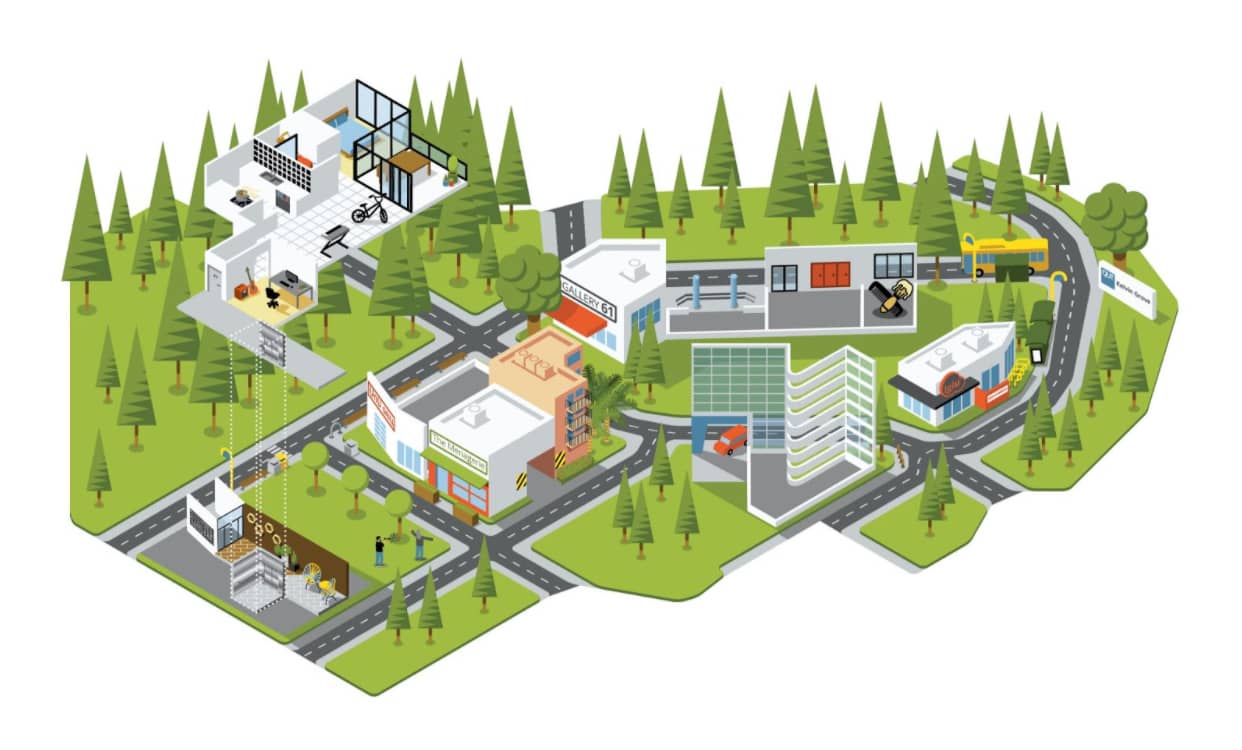
There are a few more tricks you’ll want to know about, so if you’re interested in this application of the journey method, here’s how to memorize any speech .
Basically, I memorized up to 17 words of this speech at a time on a single station. Once set in place, it was just a matter of combining the journey method with a small amount of spaced repetition .
It clearly worked well because this memorized presentation has gone on to garner millions of views.
Playing Cards
A very cool way to practice memory techniques is to memorize a deck of cards .
If you develop your skills, you can learn to encode several cards per “memory space.” My friend Dave Farrow told me he can encode up to six cards per station.
His approach is quite unique. Others use a system based on the Major Method .
This is one of my favorite applications of this technique.
When I present at live events, I use the room itself as a journey and simply memorize each name as it is presented to me.
People are astonished when I call out each name in the room.

Are You Ready To Start Journeying?
I’ve given many talks and demonstrations. On top of learning a lot about languages and passing my PhD exams with flying colors, using this technique has been a lot of fun.
The only sad part is how people witness my use of these skills only to say that they could never learn to use such a skill.
That’s simply not true.
Anyone can learn to use the Journey Method.
The only question is:
Do you want to benefit from this secret weapon?
If so, I’m happy to help make that happen. If you have any questions, post them below or get in touch.
In all things, enjoy your journey with this incredible memory technique!
Related Posts
Looking for an extensive Magnetic Memory Method review? Listen to Jesse Villalobos show you how…
Memory improvement gurus promise you can use their "memory systems." Here are 8 reason why…
Last modified: August 27, 2023
About the Author / Anthony Metivier
2 Responses to " The Journey Method: Your New Secret Weapon for Remembering "
Hi Anthony! With warm regards, my name is Mark Rudy. Reading about this blog of yours called “The Journey Method: Your New Secret Weapon for Remembering” is truly fascinating! I can see (visualize) clearly how powerful it is. But I have a question, I simply don’t understand on how to apply it.
Here’s how it goes: If we are about to likened this on the memory palace method, can we treat each step that we’ve made on the journey as “stations”? Or that’s basically the idea behind listing and planning first the journey?
Your reply will be greatly much appreciated! Thanks in advance.
Cantomayor, Mark Rudy, D. February 4, 2023
Thanks, Mark.
Yes, any stop can be called loci or a station. I prefer stations or Magnetic Stations in my practice, but the terms aren’t nearly as important as diving in and using the skills.
In my mind, the journey method differs from the Memory Palace simply in that it is the outdoor version of the indoor technique. In my experience with it, there certainly are some nuances to account for.
For example, in the beginning, I used to not do well with bridges when journeying over them and using them to place images in space.
But that has since resolved with a fair amount of practice doing it.
Leave a Reply Cancel reply
Your email address will not be published. Required fields are marked *
Save my name, email, and website in this browser for the next time I comment.
I accept the Privacy Policy
POPULAR POSTS
- How to Remember Things: 18 Proven Memory Techniques
- How to Build a Memory Palace: Proven Memory Palace Technique Approach
- How to Learn a New Language Fast: A Step-by-Step Guide
- Digital Amnesia: 5 Ways To Stop The Internet From Ruining Your Memory
- 15 Brain Exercises & Memory Exercises For Rapid Remembering
- The Memory Palace of Matteo Ricci
- Effortless Conference Interpreting: 7 Career-Making Memory Tips
- How To Teach Your Kids Memory Techniques
- 5 Unconventional, But Proven Note Taking Techniques
Recent Posts
- From Life Crushing Anxiety To PERFECT Calm: USA Memory Champ John Graham’s BEST Stress-Busting Tips
- Do Brain Games Work? Here’s A Better Way To Fix Your Memory
- How To Prepare For A Debate: 8 Ways To Win & Build Reputation
- 3 Polymath Personality Traits Masterful People Nurture & Amplify
- Lifelong Learning: The Benefits in Life and in Today’s Job Market
Pay with Confidence

Memory Courses
- The Magnetic Memory Method Masterclass
- The Magnetic Memory Method Masterplan
- How To Learn And Memorize The Vocabulary Of Any Language
- How To Learn And Memorize Poetry
- How To Memorize Names and Faces
- How to Memorize Math, Numbers, Simple Arithmetic and Equations
- How to Remember Your Dreams
Quick Links
- Testimonials
- Privacy Policy
- Privacy Tools
- Terms of Service
P.O. Box 933 Mooloolaba, QLD 4557 Australia
Memory Improvement Blog
- How to Build A Memory Palace
- Eidetic Memory
- Episodic Memory
- Photographic Memory
- Improve Memory for Studying
- Memorization Techniques
- How to Memorize Things Fast
- Brain Exercises

- The Magnetic Memory Method Podcast
- Memory Improvement Resources for Learning And Remembering

COOL MEMORY TECHNIQUES!

GET YOUR FREE 4-PART VIDEO MINI-COURSE
Improve your memory in record time! Just enter your email below now to subscribe.
- How to learn anything at lightning fast speeds
- Improve your short and long term memory almost overnight
- Learn any language with and recall any information with ease

Daniel Love
The Lucid Dreaming Guide
The journey technique.

Introduction
The Journey Technique is Daniel Love's comprehensive mindfulness technique for the induction of lucid dreaming.
The technique is primarily designed to induce a Wake Initiated Lucid Dream (WILD), but can also lead to a Dream Initiated Lucid Dream (DILD) should continued awareness become broken.
It combines multiple proven stratergies designed to address various elements required for lucidity.
Daytime practice focuses on an increasing mindfulness, observation, prospective memory, and focus. Night practice builds upon the daytime practice to aid in visualization in order to transition into a WILD.
A comprehensive video tutorial can be found here .
The Technique
1 - Establish a journey you take on a daily basis.
During your daily life, choose a journey you take often as the focal point for this technique, ideally this should be a daily journey or commute. This must be a journey you are very familiar with.
Examples include: walking to work/school, your jogging route, walking the dog, the journey between your house and a local shop, etc.
2 - Choose your focal points.
The next time you take this journey, pick five stable points of interest, five personal landmarks on the journey.
Examples include: a well-established plant or tree, a building, a street sign, a crack in the pavement.
I recommend a variety of different focal points, some organic and more prone to change, others solid and unlikely to change. `
3 - Familiarize yourself with your chosen focal points.
When taking this daily journey, become familiar with your chosen focal points. Get to know them well. Be vigilant in your observations.
If you notice any changes from day to day, perform a reality check .
4 - At night, visualise your journey.
If you wake during the night, especially in a period where returning to REM is likely, allow yourself to fall back into sleep while vividly imagining your daily journey, step by step, in as much detail as possible.
Engage the same level of observation and preparedness to reality check that you would employ during your waking journey.
5 - Observe results and record
If successful your visualization will smoothly transition into a WILD, failing that, if consciousness is broken, a DILD.
If unsuccessful, attempt this technique whenever you wake again during the night.
As always, record whatever dreams you experience upon awakening.
Author/Inventor:
Skill level:.
Intermediate
Lucid Dream Type:
Maintained Awareness (WILD)
Effectiveness: (anecdotal & community reported)
Sense preference suited:, hints & tips:.
Choose a variety of focal points, each with a differing levels of stability. Plants, for example, are more prone to change than buildings. So a combination of organic and non-organic focal points are best.
Become deeply familiar with your focal points. You should develop a level of familiarity that would allow you to describe them in exquisite detail.
Perform a reality check whenever a focal point changes in any way.
EXPAND YOUR MIND
Looking for advanced lucid dreaming techniques?
Visit our YouTube channel for hundreds of FREE
lucid dreaming tutorials...

- Study Techniques
- Moral Stories
- Funny Jokes
- Study Skills
- Memory Techniques
- High School Study Tips
- Interesting Facts
- study techniques
- memory techniques
- the journey method
The Journey Method
Main Memory Techniques Page

- Journey Management
- Lone Worker Management
- Incident Reporting
- Hazard Identification
- Safety Observations
- Audits and Inspections
- Alertness Tracking
- Training Tracker
- Mining, Oil and Gas
- Manufacturing
- Construction and Engineering
- Transport and Logistics
- Health and Community Services
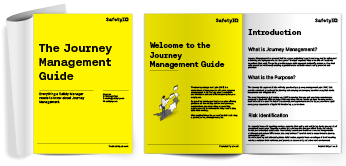
Journey Management Plan: Everything You Need To Know
The journey management plan is a cornerstone of many aspects of human resource management. A JMP can be used to establish and maintain a safe and efficient journey for your employees.
By providing training and tools, as well as offering guidance on how to stay safe on their journeys, organizations can ensure they are providing employees with the information they need to stay safe while working.
After reading this guide, you will be able to develop a perfect journey management plan. Here is what we have covered in this article.
What is a Journey Management Plan?
- What Is the Purpose of a Journey Management Plan?
How Can You Successfully Develop an Efficient Journey Management Plan?
Best journey management software.
- Factors Affecting Effective Journey Management Plan
- Top Tips For a Journey Management
Frequently Asked Questions
A Journey Management Plan is a standard procedure for planning and carrying out road transport routes following HSSE criteria, to arrive safely. For travels lasting more than 2 hours, it is advisable to implement a Journey Management Plan.
With a JMP, you can effectively manage remote workers. In one place, you can track who is working where and when, send them reminders to get up to speed, and usually make progress on tasks that are no longer prioritised.
Simple, effective, and affordable that’s how we see a journey management plan. A journey management system is an online application built to help your employees stay focused and on track with their work.
You can effectively manage your remote workforce by setting up a JMP with all the key information you need to know about the employees who work from home.
What is the Purpose of a Journey Management Plan?
The purpose of a journey management plan is to ensure that your remote employees have a high-quality experience while they're on the job.
The most important part of setting up a JMP is ensuring that you and your team members are prepared to deal with different issues that may arise daily as remote workers.
Due to the changing nature of work, businesses need to be able to effectively manage remote workers.
In this digital era, you don’t need to spend hours examining paper-based journey management plans. Using journey management software is the most reliable, time-saving, and affordable way to develop a successful JMP.
Now the question is what’s the best journey management software?
SafetyIQ is an easy-to-use journey management app that provides a complete software solution for managing the hazards of both travelling and working in hazardous situations.
More than simply a travel safety app, you get all you need to plan, assess, authorize, and monitor journeys in one simple platform that can be tailored to your specific requirements.
SafetyIQ Journey Management software entirely digitizes paper-based forms and gives centralized insight into all elements of worker movements.
Real-time answers and quick communication enabled by mobile technologies help to minimise the incidence of accidents, injuries, and delays among distant employees.
Benefits of Using SafetyIQ Journey Management Software
SafetyIQ Journey Management System enables employees to quickly and simply schedule trips and get clearance before leaving from their phones or desktop computers.
Employers can readily examine these trip plans from their phone or computer, allowing them to manage risk while on the road.
Here are the benefits of using SafetyIQ journey management software.
- The SafetyIQ mobile app allows you to manage travels on the move.
- Plan, evaluate, and approve journeys as soon as possible.
- Proactive and customizable risk assessments .
- Automate planning, approval, and monitoring procedures to save time.
- Access everything you require from a single, straightforward real-time platform.
Click here to request a demo of SafetyIQ Journey Management Software.
Factors Affecting Effective Journey Management
Journey management plans should address the safety of employees. Factors affecting employee safety include driving conditions, weather and roadway conditions, equipment and machinery used in construction work, customer contact, work practices, and equipment maintenance.
Effective journey management plans can help ensure that all employees are as safe as possible, as well as increase productivity.
To create an effective JMP, first, you must ask yourself what factors affect the safety and productivity of your business.
There are several things that should be considered, including the type of industry or business you are in, and the types of products or services you are selling.
You may also choose to add in other factors such as age distribution among employees and income disparity, employee turnover rate , and the number of workers per shift.
Once this is done, it will be easier to develop a JMP that will provide safety measures while still providing businesses with productivity benefits.
Top Tips For Journey Management
- Plan your journey.
- Plan your fatigue break checkpoints.
- Check that you can maintain communication - SafetyIQ Blackspot Map
- Consider your journey alternatives - various sorts of roads
- Examine the traffic and weather conditions.
- Allow additional time for possible delays when planning your route.
- Identify dark spots/hazardous routes - SafetyIQ Blackspot Map
- Consider the schedule of your travel and how congested the roads will be.
- Determine high-risk areas.
- Keep yourself hydrated throughout the journey.
The Journey Management Plan helps support your team’s journeys and improve their productivity . This plan is so much more than a checklist to reduce wasted time but is a strategic roadmap for effective team management that focuses on how you should be using team resources to create value. You will save money by using SafetyIQ Journey Management Software . Spend only a few bucks a month to save hundreds of hours of administrative and paperwork labour.
Q: What Does Journey Management Mean?
A planned and organized method for lowering transportation-related hazards within an organization's operations is known as journey management.
Q: What is Journey Risk Management?
A scientific method for ensuring safe and effective travel is called "journey risk management." It entails documenting the identified risk factors and accompanying mitigation actions on specific routes, which may subsequently be used to develop a route management methodology.
Q: What is Journey Management Software?
Journey Management software helps you plan, manage and execute your journeys. It allows you to structure and manage journeys while minimizing costs.

Q: Why is a Journey Management Plan Necessary?
Journey management plans are an important component of building a safe, effective and efficient travel management system. By using your journey management plan, you will establish a clear path for every employee to follow to safely complete their duties.
We cover a range of topics in our articles - view all blogs .
SafetyIQ’s journey management software can help to control the risks and protect your people.
Journey management software program can allow employers to be instantly alerted when an employee has not checked-in.
From planning the journey, completing a risk assessment to gaining approval, the entire process is automated and seamless with SafetyIQ.
Get more actionable insights in your inbox!

Copyright © 2024 SafetyIQ Pty Ltd. All Rights Reserved.
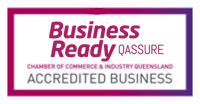
Consent Preferences
AFK Journey - 9 Beginner Tips
Get your AFK Journey started with these tips and tricks to get the most out of beginning the game.
Quick Links
Beginner tips for exploring the map, all heroes are not equal. aim for the best ones, understand leveling up and ascension mechanics, build an effective starting team, beginner tips for easily obtaining invite letters, tips for managing your inventory, advance your afk progress to unlock new game modes, being social is to your advantage, participate in weekly events to earn more rewards.
AFK Journey is a game that is highly suitable for fans of the Idle RPG genre. It offers more than just a simple Idle RPG experience. With its animations, character designs, expansive map, and advanced multiplayer features, it's quite impressive. In the game's story, you portray the great wizard Merlin, who loses his memory, keeping this a secret from everyone except those closest to them.
AFK Journey Codes - Updated Daily
The game's intricacy may initially pose a challenge, making it difficult to grasp all its mechanics and determine where to start. If you want to play with a good understanding of the mechanics and seek tips, then this guide is perfect for you.
When you're just getting started, map exploration can make a big difference. Here are a few tips for handling the map.
The Resonating Hall section of the game is divided into Hands of Resonance and Resonance Heroes. Only the heroes in Hands of Resonance can level up. However, you can freely swap these heroes with the heroes in the Resonance Heroes section.
You also need to know the Resonance Level, which is determined based on the lowest-level hero in the Hands of Resonance . Furthermore, you don't need to level up the heroes in the Resonance Heroes section; their level is equal to your Resonance Level.
Also, the heroes in the Hands of Resonance cannot exceed the Resonance Level by more than ten levels.
Your heroes require Gold and Experience to level up. You can earn these resources in abundance by exploring, battling, or through rewards from AFK Progress.
Additionally, your heroes will need Essence to level up every ten levels. Obtaining Essence may be slightly more challenging compared to Gold and Experience.
The game features an Ascension system, which is a feature you need to know to increase your heroes' stats. You will need copies of your heroes or Acorns specific to their factions to increase your Ascension tier rather than gold and experience.
Although you may find plenty of acorns in the early game, you'll come to realize the value of each acorn in the late game. Therefore, it's wise to make a plan from the start and avoid spending acorns unnecessarily on heroes who aren't worth it.
One of the most important things to know in battle is the Faction Bonus . If at least two characters in your team are from the same Faction , you will gain this bonus. If you wish to fully benefit from the bonus, you can also make your entire team from the same Faction.
In addition to these, remember that the Celestial and Hypogean factions count as belonging to every faction. Therefore, regardless of which faction you place them in, they will not prevent you from receiving the faction bonus.
Another approach you can follow regarding the Faction Bonus is to select three of your heroes from the same faction and choose the remaining two from heroes suitable for your team.
When it comes to the classes in your team, you can follow a path based on your playstyle, but you'll find the best team through trial and error. Nevertheless, for starters, having a Tank on the frontlines capable of absorbing damage and drawing enemy focus will be beneficial.
Additionally, since you need to deal damage to opponents, having at least two DPS characters in your team can be advantageous. Lastly, since your heroes will inevitably take damage and lose HP, having one Support in your team will make it easier for you to survive longer in battles.
In the battle system of the game, your heroes fight automatically. However, you still need to position your heroes before the battle begins. In pre-battle positioning, you should place them in appropriate hexagons according to the roles in your team.
While you need to place a tank character to the front , be sure to place your fragile units, such as archers, towards the back as much as possible. Additionally, before the battle starts, you can see from the menu on the right which enemies and units in your team will be focused on. Positioning according to this will give you an advantage.
You can recruit new heroes from the Noble Tavern in the Mystical House section. For this, you will need Invite Letters. Here's how to easily and quickly obtain Invite Letters:
AFK Journey has an innovative system for inventory. You don't need to individually equip your characters. Instead, the equipment you give to classes will be worn by heroes belonging to that class.
Additionally, you can use Quick Equip to ensure that classes wear the best equipment available.
In the AFK Progress section of the game, you battle through waves of increasingly powerful enemies . This will be the first game mode you encounter in the game, and you need to reach certain levels in this game mode to unlock others.
Advancing your stage in AFK Progress is crucial for you. This is because it affects your idle rewards . Additionally, if you trust your team after reaching AFK Stage 10, you can use the Auto Battle feature to engage in consecutive battles automatically.
AFK Journey is also a social game. This means that making friends can be to your advantage . By making friends with other players, you can complete challenging battles together.
Additionally, you can exchange gifts with your friends and earn tokens from the shopping section to access special items. Furthermore, when your AFK Stage reaches 30, you can join guilds.
After joining guilds, if you have also progressed your AFK Stage, you can participate in special boss battles with your guildmates .
Be sure to take advantage of Weekly Events as well. By logging in daily throughout the week , you can claim your rewards. This way, you can obtain useful items such as Invite Letters , Hero Chests, and more. The "Journey’s Gift" section is related to this.
Through the 'All Heroes Available' section, you can acquire heroes as you log in. This allows you to unlock heroes you don't have or easily ascend them by obtaining duplicates.
The higher your consecutive login count, the more likely you are to unlock S-Tier heroes on the seventh, 14, 21, and 28 days. Celestial and Hypogean heroes are also included among them.
AFK Journey: How To Choose Your Server And Add Friends
AFK Journey: How to Get Soulstones (& How to Use Them)
You need Soulstones to collect more Dupes and Ascend your AFK Journey team faster; here’s how to get and use them.
Soulstones serve as powerful Ascension boosters in AFK Journey , facilitating the rapid leveling up of your Heroes. However, acquiring Soulstones can be challenging, and many players are unsure of how to effectively utilize them. This guide aims to clarify the process of obtaining and using both A-Level and S-Level Soulstones and offers tips on maximizing their utility.
AFK Journey: Honor Duel Guide
Soulstones explained.
Soulstones are summoner items for Soul Sigils . Each time you use 60 of them, you summon a Hero Dupe. The Dupes can be either A-Level or S-Level , depending on the type of Soulstone used. If you use A-Level stones, you’ll receive a Hero of A Rarity, while S-Level Soulstones will yield a Hero of S Rarity.
How to Get Soulstone
There are four ways to obtain Soulstones: Nobel Path prizes, Corrupt Creature event rewards, Growth Path missions, and Daily Quests .
Claim Nobel Path Rewards
The most common method of acquiring Soulstones is by increasing your Nobel Path level . Through completing quests, shopping for items, or logging in, you earn Milestone Points, which unlock Fun Travelogue or Secret Travelogue prizes. Every five ascensions on this path grant 20 A-Level Soulstones to regular players and 60 A-Level Soulstones to premium players.
The Secret Travelogue is AFK Journey’s season pass, which requires microtransactions to unlock.
Participate or Start Corrupt Creature Events
A lucrative source of Soulstones is Corrupt Creature. In this limited PvE event , up to three players face formidable opponents. By becoming a captain (event starter) or an assistant, you can earn up to 60 A-Level and S-Level Soulstones from Corrupt Creature matches. However, keep in mind that the number of these events is limited on your map. Be sure to monitor the Team-Up menu in the chats section to join other players’ games when your Corrupt Creature events conclude.
Complete Daily and Growth Path Objectives
Navigate to the Quests menu to find Daily and Growth Path objectives that require in-game actions, such as reaching a specific Resonance Level or completing story missions. By fulfilling these requests, you can collect up to 200 Soulstones , mostly A-Level. The benefit is that many of these requests are naturally fulfilled as you progress through the main story or AFK Stages.
How to Use Soulstones
Whenever you accumulate 60 Soulstones, visit the Inventory to utilize them . (You can access the Inventory from the main menu under the Event , Trolley, and Quest sections.) When you have enough Soulstones, a small circle will appear next to the Inventory icon. By tapping the stone, you can summon one random Soul Sigil (Hero Dupe) corresponding to the type of stone you’re using: A-Level or S-Level.
If you’re unable to farm Soulstones, consider purchasing Soul Sigils directly from the Emporium stores . The Guild Store and Arena Store sell S-Level Sigils, while the Recruitment Store and Dream Store offer A-Level equivalents.
AFK Journey

Up the mountain: A practical guide
This article itself is a journey in some ways; ergo, it provides a practical guide for CTE educators to use in their classrooms and with students.
At the beginning of each semester, I ask my students to imagine they are standing at the bottom of a mountain. There is a waterfall. They are surrounded by wildflowers and dragonflies, and bees are buzzing about. The students learn that I am their guide. I will lead them up the mountain to discover a wonderful treasure.
As they stand on the ground, the first week of the term is their time to become accustomed to things. Because we will start climbing the mountain soon. But it’s not at the summit where we’ll find the treasure. The instructor and their students will develop stamina, courage and confidence on the path. The point is this: We have a long journey, and we have much to learn from each other along the way. Then, as the sun’s light shines down and quiet streams snake through the valley, they will begin to see all the possibilities that lie ahead.
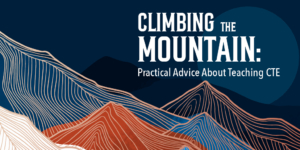
The CTE student
CTE does not speak to one set or type of individual. However, these students have a similar goal: They all want an education and skills that will better prepare them for careers. Another common trait among many CTE students is that they want to know the value of what they are learning (Knowles et al., 2005). They understand the basic need for technical skills and knowledge, but instructors should seek to connect all coursework to its real-world impact.
The CTE instructor
Prior to my role as a clinical instructor in the College of Technology at Idaho State University, I was a student. This statement seems obvious, but it’s a fact that students can easily forget. My background is in English, but I began my educational journey at 25. I was a nontraditional student. I was, and am, a writer. But I had no interest in teaching or helping people become better at writing.
Then something changed. I had an opportunity to teach a course, and the moment I was standing in the class, with all eyes on me, I knew. Being able to help students achieve their dreams and be successful was the bug that bit me. Over the years I’ve been teaching, I’ve learned five ways to improve and become more effective. Now I want to share this practical guide with other educators.
1. Establish a rapport.
Building a rapport with your students is about establishing a relationship; it is about trust. Rapport does take time, but in the condensed atmosphere of the semester, it may happen quicker than you think. Engage in informal conversations prior to and after class, during office hours, through email, or on Zoom calls. I work to establish those connections with my students from day one. I tell them stories of my journey as a student, which I pepper throughout the term. These stories humanize me and help the content make more sense.
2. Make the coursework relevant.
Students want to know how the coursework relates to their studies or to life outside the classroom. There are no signposts on the mountain path, so, as guides, we must show students where they’re going and how to get there. I tackle this challenge with writing and communications content by relating it to functional literacy. For example, one semester, the elevator was broken. My class was on the third floor, so to connect the point of living in a literate world, I asked students how they arrived at the class. That is, how did they know the elevator was broken?
3. Show students that you care.
To care for your students is to be engaged and interested, not only in their goals, but in their success. When I first started teaching, I treated teaching like a side hustle. I already had a full-time job, so adjuncting was a way to earn extra income. Then I met an educator who was also my mentor, and he taught me the principle of caring. Students can tell when an instructor is sincere or not. So, now, I try to always be sincere. I share my experiences as a student. I apologize to students when I make a mistake, and I hold students accountable for their mistakes.
4. Plan. And then plan some more.
Personally, my secret to teaching is overplanning. With extensive planning, you build your regular coursework for the semester, then develop extra assignments or lessons that can be used to extend a lesson or in case of an emergency. And the beauty of overplanning is students won’t know it was extra unless you tell them. Overplanning can also help when students grasp a concept faster than expected.
5. Trust your process.
Finally, we must trust our process. The semester is a mountain, but it is a mountain we have climbed before. If you are just starting teaching, lean into the more experienced instructors in your department. I would also recommend reading Peter Filene’s The Joy of Teaching . This book offered a really great practical guide when I first started teaching. Creating a process, like walking up that mountain, takes time, but you will get there, little by little, as you gain experience and engage with students and the curriculum.
What I have learned
What I have learned from CTE and teaching CTE students is to never give up. CTE students are determined and focused. And they have grit. They are eager and willing to learn; they are engaged in their learning process. So, as I guide them up the winding path and through obstacles, I never give up. Because I want to see them succeed.
Timothy O. Davis, AOS, MS, MFA, is a clinical instructor in the College of Technology at Idaho State University.
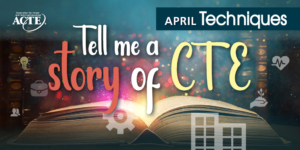
Read more in Techniques: Tell Me a Story of CTE.
- ACTE’s Mission
- Get Involved
Press Center
- Press Releases
- CTE in the News
- What Is CTE?
- State Fact Sheets
- Economic Impacts
Publications
- CTE Publications
- CTE Policy Watch Blog
- Take Action
- Advocacy Resources
ACTE® 1410 King Street, Alexandria, VA 22314 P: 800-826-9972 F: 703-683-7424
Professional Development
- ACTE Awards
- High-quality CTE Tools
- Leadership Development
- Online Learning

- Season 31: Season of the Forbidden Archives - Now Live

Sanctuary needs you to answer its call for aid in Season 31: Season of the Forbidden Archives. Starting on April 12 at 5 p.m. PDT/CET/KST , Nephalem can harness the power of Forbidden Archives theme, which first debuted with Season 20. For an in-depth look into what’s coming, read below.
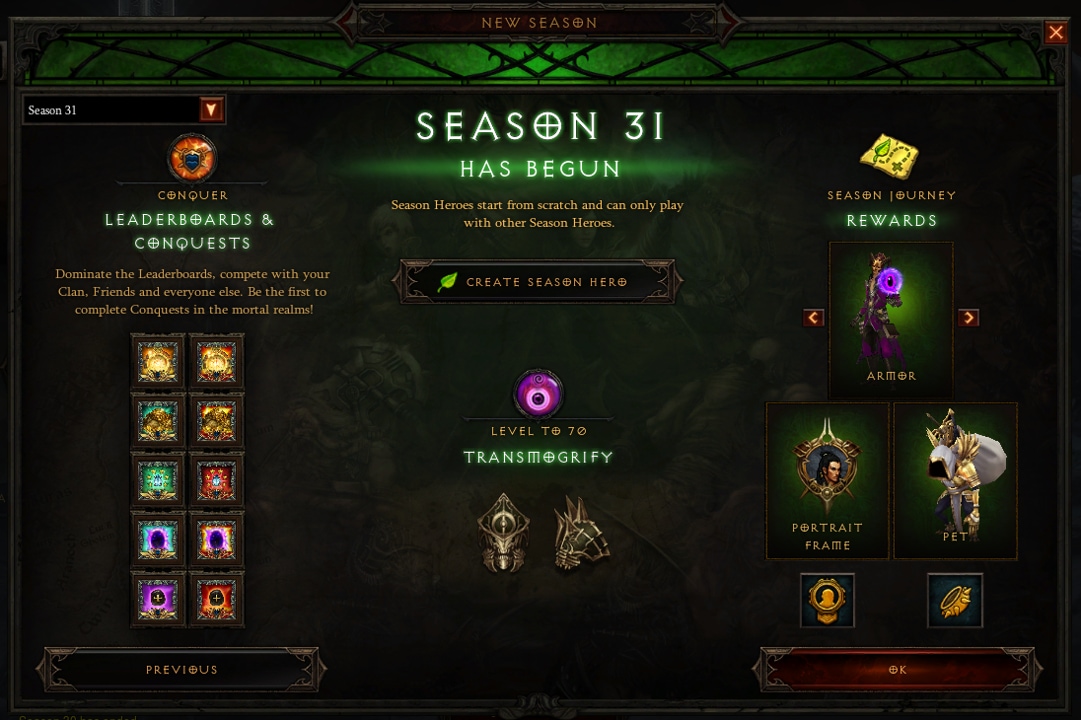
Seasonal Journey
Season theme.
Season Cosmetic Rewards
Season Journey Rewards
Seasonal conquest, haedrig’s gift.
Patch 2.7.7 Notes
Season 31 is the Season of the Forbidden Archives. Many adventurers have come to learn the power that dwells within the ancient nephalem artifact, Kanai’s Cube. However, none understands this power better than the equally celebrated and reviled Horadrim, Zoltun Kulle. Kulle was able to unlock and harness the power of the Cube like none before, leveraging its power to siphon and archive the energies of powerful items. With Season 31, we explore the power Kulle might lend to your fingertips if his experiments went unchecked.
For the duration of Season 31, the slots in Kanai’s Cube that allow you to equip three additional Legendary powers will not be restricted to their usual categories. While normally a player can equip one power each from the Weapon, Armor, and Jewelry categories, Season 31 players can mix and match between all three! This might allow you to run two Weapon powers with one Armor power. Or perhaps you might choose to run three Amulet powers instead. The choice is yours, and we’re as eager as you are to experiment with the new build opportunities this creates!
Return to Top
Season 31 Cosmetic Rewards
Beginning with Season 17, we began re-introducing previous Seasonal rewards to make them available to players who may have missed them the first time around. For Season 31, this means awards originally available from Season 7 are returning to the Season Journey.
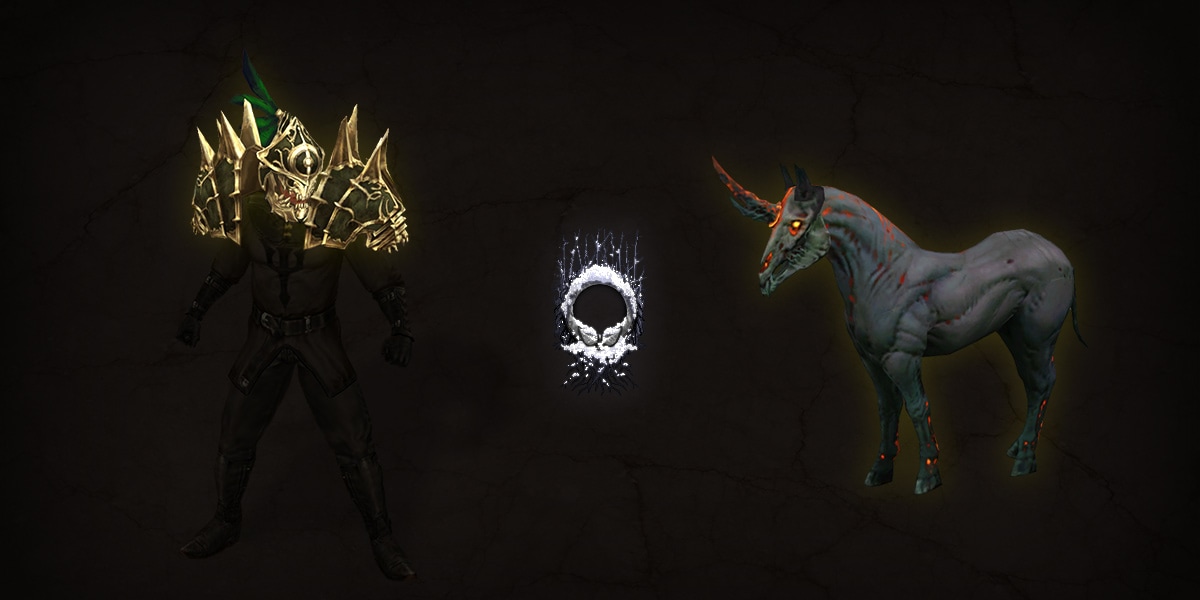
However, we know it’s nice to have something new to aim for if you’ve participated in previous Seasons. We’re bringing back End of Journey rewards as introduced in Season 17, with not one, but two new cosmetic rewards for those who complete the entirety of the Season journey. Feast your eyes upon the Valor Portrait Frame and Angelic Treasure Goblin pet !
In addition to the Helm and Shoulders slots of the exclusive Conqueror Set, you’ll be able to earn a series of portrait frames that embody the snowy, foreboding aura of the Eternal Woods. If you need a warm little pal to keep you cozy through your cold journeys, the Dream of Piers fiery nature should do the trick—when he’s not instilling night terrors in the local fauna.
If you’ve been diligently slaying demons for the past few Seasons and reached Conqueror in the Season Journey each time, you’ve surely accrued a few extra stash tabs. You’ll earn one additional tab each Season by finishing the Conqueror tier, up to a maximum of five :
- Guardian of Sanctuary: Finish a level 70 Nephalem Rift on Torment XIII within five minutes.
- Gem of My Life: Level three Legendary Gems to level 55.
- All I Do IS Win: Complete two Conquests this Season.
- Kill You: Kill Ghom at level 70 in under 30 seconds on Torment XIII difficulty.
- Money Ain’t A Thang: Slay Greed on Torment XIII difficulty.
- Take U There: Reach Greater Rift level 60 Solo.
- Power Amplification: Use Kanai’s Cube to augment an Ancient Legendary item with a level 50+ gem.
- Cubic Reconfiguration: Use Kanai’s Cube to reforge a Legendary item.
Want to prepare your Conquest plan for Season 31? Here are the challenges you’ll face! Returning for Season 31 is Sprinter/Speed Racer , where you’re challenged to complete the entire Diablo III campaign from Act I to Act V at level 70 in under 1 hour! Next is Avarice/Avaritia , where all that glitters is gold—that is, if you can complete a 50 million gold streak outside of The Vault or its Inner Sanctum. On a Good Day/I Can’t Stop encourages you to upgrade your Legendary Gems; level three Legendary Gems to 65 to complete this challenge! Push your way to Greater Rift level 75 to complete Divinity/Lionhearted. Lastly, a fan-favorite for those who enjoy unconventional builds, The Thrill/Superhuman requires completion of a Greater Rift level 45—solo and without any Set items equipped.
Finally, the Class Sets rewarded for completing certain chapters in the Season Journey courtesy of Haedrig’s Gift have rotated once more. We’ve listed the available Sets below. For those new to Seasons, here’s how it works:
Completing Chapters 2, 3, and 4 of the Season Journey will reward you with three of Haedrig’s Gifts. Each Gift contains a few pieces from one of your Class Sets. Players can only unlock one Class Set in this manner per Season across Hardcore and Non-Hardcore, so choose wisely!
The set you receive depends on the class of the character you’re playing when you open each Haedrig’s Gift. To collect a full Class Set, you’ll need to open all three on the same character.
Here are the sets granted by Haedrig’s Gift in Season 31:
- Barbarian – Wrath of the Wastes
- Crusader – Roland’s Legacy
- Demon Hunter – Unhallowed Essence
- Monk – Raiment of a Thousand Storms
- Necromancer – Bones of Rathma
- Witch Doctor – Helltooth Harness
- Wizard – Tal Rasha’s Elements
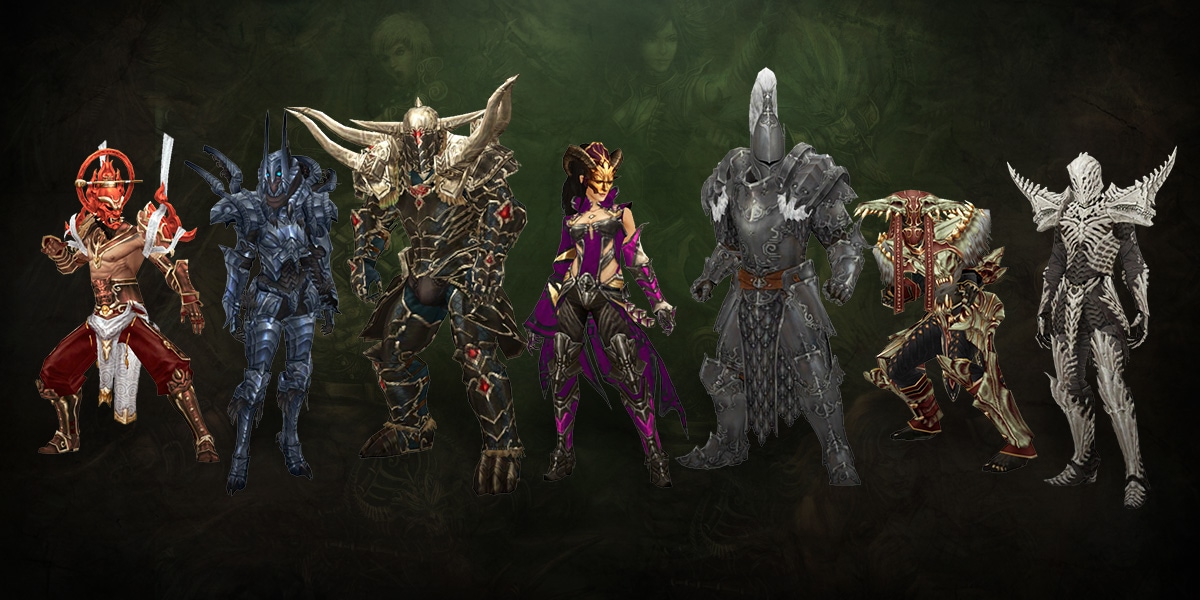
Patch 2.7.7 | Game Updates
- Updated Logos for KR Age Restriction from 18 years of age to 19 years of age.
- Extra progress orb drops from the Soulshard Stain of Sin now works for Challenge Rifts.
- Extra progress orb drops from the Soulshard Stain of Sin and Altar of Rites node Reaper now only drops from monsters inside Nephalem Rifts, Greater Nephalem Rifts, and Challenge Rifts.
Stay Connected
- Milano Cortina 2026
- Brisbane 2032
- Olympic Refuge Foundation
- Olympic Games
- Olympic Channel
- Let's Move
NBA Playoffs 2024: An Olympic fan's guide to the basketball tournament

The 2024 NBA (National Basketball Association) playoff field is set following a dramatic conclusion to the regular season on Sunday (14 April).
While the 1 vs 8 and 2 vs 7 seed matchups will be determined through the Play-In Tournament taking place later this week , the four other series in the East and West are set —and there will be plenty of international Olympic talent on display throughout the playoffs.
For fans of the NBA and the international game alike, here are six Olympians to watch throughout the 2024 NBA postseason.
*As National Olympic Committees have the exclusive authority for the representation of their respective countries at the Olympic Games, athletes' participation at the Paris Games depends on their NOC selecting them to represent their delegation at Paris 2024. Click here to see the official qualification system for each sport. *
Nikola Jokic, Denver Nuggets & Serbia (1 x Olympic appearance, Rio 2016 silver medallist)
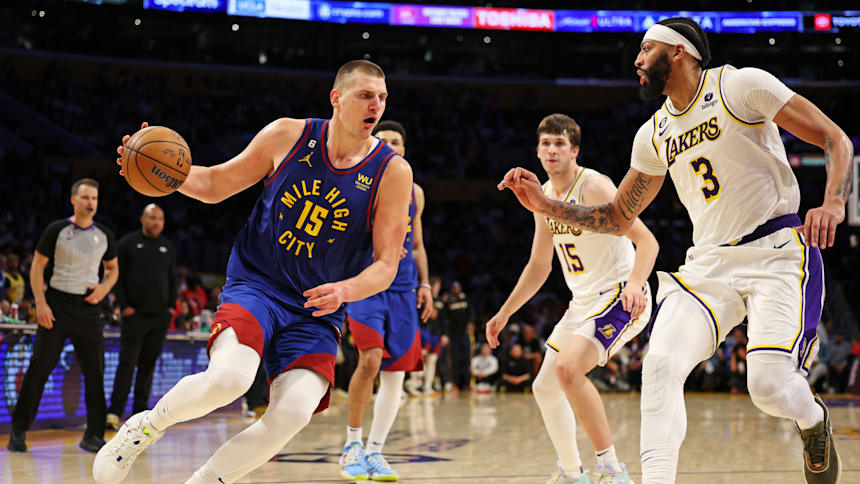
Nikola Jokic of the Denver Nuggets drives against Anthony Davis of the Los Angeles Lakers.
We begin with the reigning league and Finals MVP (Most Valuable Player) who, incidentally, is currently the favourite to win a third league MVP award following a season in which the 29-year-old posted per game averages of 26.4 points, 12.4 rebounds and nine assists on 58 per cent shooting the field—statistics that place him in the top 10 of every category in the entire league.
Unsurprisingly, Jokic helped lead the Nuggets to a 57-25 record and the No.2 seed in the stacked Western Conference, which means the New Orleans Pelicans or Los Angeles Lakers will face the daunting task of slowing down the 2.11m (6 ft 11) big man.
Jokic was absent from the Serbia squad that lost to Germany at the FIBA World Cup 2023 final, having earned some well-deserved rest after helping Denver win its first championship in franchise history. But with the Olympic Games Paris 2024 quickly approaching, is it more likely we’ll see the Joker make his first Olympic appearance since winning silver in Rio back in 2016? According to a December interview with Aleksandar Zigic of RTS , Jokic is still undecided —despite Serbian head coach Bozidar Maljkovic claiming he would be part of the Eagles’ roster for the Games.
“It’s far. Some people put words in my mouth that I said something that I didn’t. The head coach is the first to know [my commitment]. I always talk to the family and the team after the season.”
In short —we’ll have to wait until Denver’s season ends to hear what Jokic’s plans are for a possible summer in France.
Shai Gilgeous-Alexander, Oklahoma City Thunder & Canada
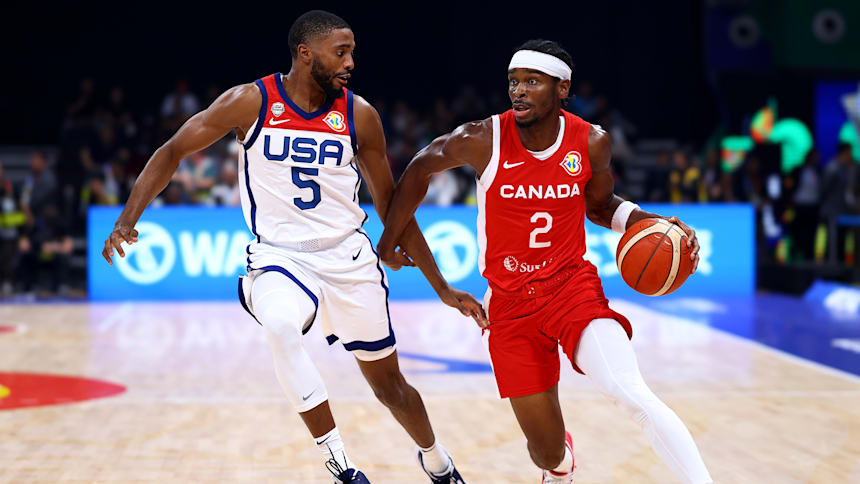
MANILA, PHILIPPINES - SEPTEMBER 10: Shai Gilgeous-Alexander #2 of Canada controls the ball against Mikal Bridges #5 of the United States in the second quarter during the FIBA Basketball World Cup 3rd Place game at Mall of Asia Arena on September 10, 2023 in Manila, Philippines. (Photo by Yong Teck Lim/Getty Images)
Yes, technically speaking Gilgeous-Alexander isn’t an Olympian... yet.
However, the 25-year-old, who led Canada to the bronze medal at the 2023 FIBA World Cup and a first Olympic qualification in 23 years, has already made clear his intentions to represent Team Canada at Paris 2024.
As the focal point of the Oklahoma City Thunder’s potent attack (120.1 points per game, third-best in the NBA), Gilgeous-Alexander possesses an elite arsenal of moves to be able to get to the rim—or free-throw line—at will, which explains why he averaged 30.1 points per game (third-highest in the NBA) and attempted 649 free throws (second-highest) this season. He’s also an absolute ball-hawk, leading the league (alongside De’Aaron Fox of the Sacramento Kings) in total steals with 150.
Obviously, Canada Basketball would be foolish to head to France without him, especially given the tough Group Canada has been drawn into for the Games . First though is the minor matter of the NBA playoffs; the Thunder, as the top seed in the West, will discover their first round opponent at the conclusion of the Play-In Tournament.
Jayson Tatum, Boston Celtics & USA (1 x Olympic appearances Tokyo 2020 gold medallist)
The Boston Celtics ended the 2023-24 NBA regular season with the best record in the league (64-18), in large part thanks to the superhuman efforts of Jayson Tatum .
The 26-year-old has been in contention for the MVP award for the past two seasons and will be again in 2024 after posting averages of 26.9ppg, 8.1 rpg and 4.9 apg while guiding the Celtics to their first 60-win season since 2009.
Tatum, who has previously represented the USA on the international stage (winning gold at the Tokyo 2020 Olympic Games in 2021), has already announced that he “would love” to compete at Paris 2024, and is part of the 41-athlete player pool for the 2024 USA Basketball men’s national team .
Luka Doncic, Dallas Mavericks & Slovenia (1 x Olympic appearance)

Doncic ’s Olympic debut lived up to expectations as Slovenia—in their first Olympic basketball tournament, no less—finished fourth at Tokyo 2020, with Doncic selected to the All-Star Team of the tournament.
Since then, the 25-year-old has continued to dominate, and in 2023-24 he almost averaged a triple-double with a league-high 33.9 points per game, 9.2 rebounds per game and 9.8 assists per game. The Mavericks went on a tear to finish the season, winning 16 of their last 18 games; Dallas will now face the Los Angeles Clippers in one of the premiere matchups of the first round, as Doncic and teammate Kyrie Irving will square off against the trio of Paul George, Kawhi Leonard and Russell Westbrook.
We could still see Doncic and Slovenia at Paris 2024 too, depending on how they perform at the FIBA Olympic Qualifying Tournament (OQT).
Franz Wagner, Orlando Magic & Germany
Yes, yes, just like Gilgeous-Alexander, Wagner isn’t an Olympian just yet, but we’d be remiss to leave him off this list, given Germany’s historic success at the World Cup last year and subsequent qualification for Paris 2024.
Wagner carried on his good form after helping Germany win the World Cup into the 2023-24 season, posting career highs in points (19.7), rebounds (5.3) and assists (3.7) per game. While teammate Paolo Banchero might be the face of the Orlando team preparing to face the Cleveland Cavaliers in the 4-5 clash in the East, Wagner is the sure-fire No.2 option and will be key to the Magic’s postseason run—not to mention Die Mannschaft’s plans for the Olympics.
LeBron James, Los Angeles Lakers & USA (3 x Olympic appearances, 2 x gold medallist (Beijing 2008 & London 2012), 1 x bronze medallist (Athens 2004)

LeBron James
Clearly, the rules of aging in elite professional sport do not apply to LeBron James who, at 39, is as powerful a force on the basketball court as he’s ever been. Sure, his athleticism isn’t quite what it was when he was drafted as a spry 18-year-old but make no mistake: the King still wears the crown in basketball.
The accolades of the NBA’s all-time leading scorer speak for themselves, and his passing ability, powerful dunks and chasedown blocks mean the basketball legend is still must-watch TV—especially now that we’ve entered the postseason.
The Lakers will have to navigate the perils of the Play-In Tournament to make the playoffs, where a date with the Nuggets or Thunder awaits, but no team will want to face LeBron James when he’s still playing at such a spectacular level.
In fact, James remains committed to playing for the USA at Paris 2024 in what would be his fourth Olympic Games, telling reporters at the NBA All-Star Game in February: "I told myself before the season, when I committed to being part of the Olympic team, obviously it was all predicated on my health.
"As it stands right now, I am healthy enough to be on the team and perform at a level that I know I can perform at."
Here’s hoping we get the chance to see the future Hall of Famer compete at the Games one more time this summer.
Related content

USA Basketball at Paris 2024 Olympics: Which NBA players will be on the team?

USA Basketball at Paris 2024 Olympics: Complete schedule and tournament format

Olympic basketball: Complete list of winners and medallists

How to qualify for basketball at Paris 2024. The Olympics qualification system explained

Paris 2024 women's and men's Olympic basketball tournaments draw: Preview, teams and how to watch live
You may like.
Follow Polygon online:
- Follow Polygon on Facebook
- Follow Polygon on Youtube
- Follow Polygon on Instagram
Site search
- Dragon’s Dogma 2
- FF7 Rebirth
- Zelda: Tears of the Kingdom
- Baldur’s Gate 3
- PlayStation
- Dungeons & Dragons
- Magic: The Gathering
- Board Games
- All Tabletop
- All Entertainment
- What to Watch
- What to Play
- Buyer’s Guides
- Really Bad Chess
- All Puzzles
Filed under:
- Sales Guide
Steam FPS Fest includes deals on hundreds of great games
Save on games like Black Mesa, System Shock, the Fallout franchise, and more through April 22
Share this story
- Share this on Facebook
- Share this on Reddit
- Share All sharing options
Share All sharing options for: Steam FPS Fest includes deals on hundreds of great games
/cdn.vox-cdn.com/uploads/chorus_image/image/73280799/english.0.jpg)
Steam’s annual FPS Fest sale is in full effect through April 22, offering some excellent deals on an impressive collection of shooters. While events like this don’t offer discounts on the Steam Deck, it's still an excellent opportunity to stock up on shooters that may have otherwise slipped under your radar. Some of our favorites include the fantastic remakes Black Mesa and System Shock in addition to the entire Fallout franchise and hundreds of other awesome titles.
/cdn.vox-cdn.com/uploads/chorus_asset/file/25395992/046bz8xw.png)
Prices taken at time of publishing.
Black Mesa , the fan remake of the original Half-Life is a true labor of love and perhaps the best way to experience this legendary FPS. Usually $19.99, you can currently find Black Mesa discounted to just $3.99 during the Steam FPS Fest. More than just a comprehensive cosmetic update, Black Mesa reworks significant portions of the original Half-Life to provide a richer and more streamlined experience.
- $4 at Steam
/cdn.vox-cdn.com/uploads/chorus_asset/file/25396709/ydzegb2g.png)
Fallout 4 GOTY Edition
If you’ve been watching the Fallout miniseries on Amazon Prime and have got the itch to revisit the post-apocalyptic RPG, the entire franchise is currently discounted on Steam. Every game and its corresponding DLC is 75% off, including the Fallout 4 Game of the Year Edition , which is slated to receive a new update on April 25. Typically $39.99, The Game of the Year Edition of Fallout 4 is on sale for just $9.99 and includes all of its post-launch DLC.
- $10 at Steam
/cdn.vox-cdn.com/uploads/chorus_asset/file/6191507/maxresdefault.0.jpg)
System Shock
Nightdive’s System Shock is a masterclass remastering a beloved classic. This version features vastly upgraded visuals and is far more accessible to modern audiences without abandoning the tone and feel that made the original so great. Nightdive recently even released a new update that features a myriad of fixes and new additions. If you’d like to book a visit to Citadel Station and experience the definitive version of this classic title, you can pick up a copy on Steam for just $17.99 (was $39.99).
- $18 at Steam
- $40 at Epic
/cdn.vox-cdn.com/uploads/chorus_asset/file/24241747/Fatshark_Darktide_3.png)
Warhammer 40,000: Darktide
The grimdark cooperative extraction shooter, Warhammer 40,000: Darktide , is typically priced at $39.99, but is available for just $23.99 during the Steam FPS Fest . While it launched over a year ago, Darktide has received a generous helping of post-launch support to allow this thematic title to live up to its full potential. Most recently, developer Fatshark launched its “Path of Redemption” update, which adds a litany of new rewards, enemies, cosmetics, and other modifiers.
- $24 at Steam
/cdn.vox-cdn.com/uploads/chorus_asset/file/25395993/z0bj0t1s.png)
Roboquest is a roguelike shooter that nobody should sleep on. This cel-shaded shooter offers a bizarre collection of weapons and abilities that can produce some truly overpowered builds. As an added bonus, Roboquest runs beautifully on handhelds like the Steam Deck, and has an awesome soundtrack. If you’d like to give this fast-paced roguelike a try, you can pick up a copy for just $19.99 through April 22 (was $24.99).
- $20 at Steam
The next level of puzzles.
Take a break from your day by playing a puzzle or two! We’ve got SpellTower, Typeshift, crosswords, and more.
Sign up for the newsletter Patch Notes
A weekly roundup of the best things from Polygon
Just one more thing!
Please check your email to find a confirmation email, and follow the steps to confirm your humanity.
Oops. Something went wrong. Please enter a valid email and try again.
Loading comments...

Keanu Reeves to voice Shadow in Sonic 3 movie, says report
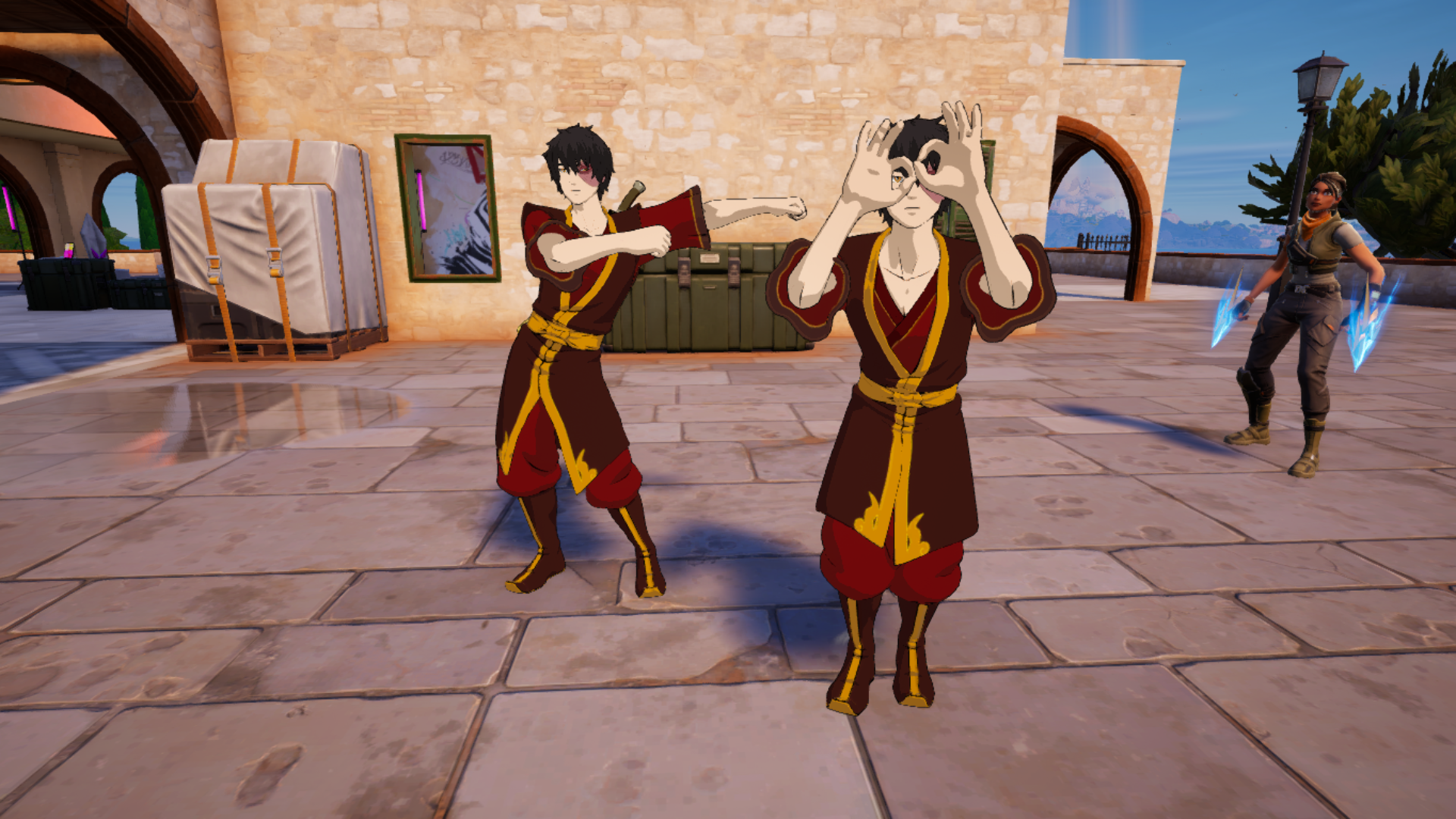
Fortnite is showing us a new side to Zuko from Avatar: The Last Airbender

- Dragon’s Dogma 2 guides, walkthroughs, and explainers
How to fast travel in Dragon’s Dogma 2

How to pass time in Dragon’s Dogma 2

Netflix’s The Circle, Conan O’Brien’s new show, and more new TV this week

Gear up for Quests from the Infinite Staircase with seven classic D&D adventures for just $32
ORTHOPAEDICS
Journey ◊ ii total knee arthroplasty.
Total knee arthroplasty patients report unmet levels of satisfaction, particularly for more active or demanding activities. 1,2 The JOURNEY II System is designed to help patients rediscover their normal through a smoother recovery, *3,4 improved function *4-8 and higher patient satisfaction *2,4-6
Normal shapes. Normal position. Normal motion
Reproduction of optimal kinematic patterns during TKA could be instrumental in improving patient satisfaction. 11 The solution to providing patients with better overall satisfaction and functionality is to design an implant as close to the normal knee as possible.
The JOURNEY II System has been shown to restore anatomical shape, position and motion. 9,10,12-14 This anatomical restoration can provide superior clinical outcomes that can lead to high patient satisfaction. *3-5,8,15
Product Features
Reference materials, medical education, related products.
* Compared to non-JOURNEY II knees.
This design rationale is for informational and educational purposes only. It is not intended to serve as medical advice. It is the responsibility of treating physicians to determine and utilise the appropriate products and techniques according to their own clinical judgment for each of their patients.
For detailed product information, including indications for use, contraindications, effects, precautions and warnings, please consult the product’s Instructions for Use (IFU) prior to use.
- Scott CEH, et al. J Bone Joint Surg Am. 2010;92-B(9):1253-1258.
- Noble P.C, et al. Clin Orthop Relat Res 2012;470(1):20-32
- Mayman DJ, et al. Poster presented at: ISPOR Symposium;19-23 May, 2018; Baltimore, Maryland, USA
- Nodzo SR, et al. Techniques in Orthopaedics. 2018;33(1):37-41.
- Murakami K, et al. Int Orthop. 2018;42(11):2573-2581.
- Di Benedetto P, et al. Acta Biomed 2019; Vol. 90, Supplement 12: 91-97.
- Kosse NM, et al. Poster presented at: 2nd World Arthroplasty Congress;19-21 April, 2018; Rome, Italy.
- Takubo A, et al. J Knee Surg. 2017;30(7):725-729.
- Grieco T, et al. J Arthroplasty. 2018;33(2):565-571.
- Smith LA, et al. J Arthroplasty. 2021;36:1445-1454.
- Van Onsem S, et al. Clin Orthop Relat Res (2020) 478:255-263.
- Iriuchishima T, et al. J Knee Surg. 2018;31(6):568-572.
- Murakami K, et al. J Orthop. 2018;15(2):650-654.
- Carpenter RD, et al. Knee. 2009;16(5):332-336.
- Noble PC, et al. Clin Orthop Relat Res. 2005(431):157-165.
- Kaneko T, et al. J Orthop. 2017;14(1):201-206.
- Brilhault J, et al. Knee. 2010;17(2):148-151.
- Catani F, et al. J Orthop Res. 2009;27(12):1569-1575.
- Hyodo K, et al. Arthroplasty Today. 2020;6(3):338-342.
- Hada M, et al. Knee Surg Sports Traumatol Arthrosc. 2018;26(6):1709-1716.
- Smith+Nephew 2012. Internal report. JRN2 KneeSim Analysis Memo.
Your guide to the 2024 UN Permanent Forum on Indigenous Issues
This year’s gathering of global indigenous leaders, activists, and policymakers puts a spotlight on youth..

This story is published as part of the Global Indigenous Affairs Desk , an Indigenous-led collaboration between Grist, High Country News, ICT, Mongabay, Native News Online, and APTN.
In 2019, Makanalani Gomes stood on the slopes of Mauna Kea , the tallest mountain in Hawaiʻi, face-to-face with Honolulu riot police . For decades, Native Hawaiians like Gomes watched — and protested — as their sacred mountain was bulldozed and excavated for the construction of telescopes and other astronomical facilities . After the observatories were built, they abandoned construction equipment and debris, littering Mauna Kea’s summit.
Gomes and other activists spent months sleeping on the mountainside, in the cold, successfully blocking construction crews from heading up the slope to build the proposed Thirty Meter Telescope , and to date, the project remains in limbo.
“We are in the fight of our lives and in the front lines every day,” Gomes said.
Grist thanks its sponsors. Become one .
To support our nonprofit environmental journalism, please consider disabling your ad-blocker to allow ads on Grist. Here's How
This week, Gomes will continue her work fighting for Indigenous self-determination and sovereignty when she speaks at the United Nations Permanent Forum on Indigenous Issues in New York — the largest gathering of Indigenous leaders, activists, and policymakers on the planet. Beginning on Monday, the 23rd annual event runs until April 26 and will focus on “emphasizing the voices of Indigenous youth” like Gomes, who is now one of three co-chairs of the Global Indigenous Youth Caucus.
The forum was established more than two decades ago as a permanent advisory body for Indigenous Peoples at the U.N., and is a uniquely influential venue for attendees to ensure their perspectives are heard. Indigenous Peoples and nations can’t vote at the U.N. like member states, but the forum has the ability to make official recommendations as an adviser to the Economic and Social Council, one of the six main U.N. bodies that helps facilitate multinational agreements on sustainable development. The forum has 16 members that serve three-year terms, with eight nominated by state governments and eight by Indigenous organizations.
“The importance of the Permanent Forum is that it puts pressure on other parts of the United Nations to take appropriate action regarding Indigenous Peoples,” said Andrea Carmen, executive director of the International Indian Treaty Council .
The existence of the forum is itself a product of Indigenous advocacy. Mililani Trask , a longtime Native Hawaiian activist and one of the first members of the Permanent Forum, said advocates used to have to sit and listen while U.N. members discussed issues relevant to them. She said that Indigenous advocates wanted a permanent space where they could speak on the floor.
“Once we were established as a body, it shifted the balance of power,” Trask said. It meant “we have a basis in working with governments in partnerships instead of going to the gun.”
Trask also said that the forum elevated Indigenous expertise.
“When the forum came into existence, it was the first time that non-white Indigenous international legal experts came to the forefront,” Trask said. Member states “didn’t think that we had any.”
She said the advisory body had a huge influence on the eventual adoption of the U.N. Declaration on the Rights of Indigenous Peoples five years later in 2007 . The U.N. document outlines the rights of Indigenous Peoples and has been a key tool for Indigenous advocates who seek to hold states and corporations accountable for human rights violations. It’s not legally binding, but it provides an international standard that Indigenous people can point to when their rights are violated.
Just two years ago, the venue enabled the Yaqui Nation in Mexico to regain their sacred Maaso Kova from a museum in Stockholm, Sweden. The deer head is used in ceremonial dances and was taken as part of the colonial enslavement and suppression of the Yaqui people. The return of the Maaso Kova in 2022 was what The New York Times reported as the “first successful repatriation of cultural artifacts to an Indigenous group overseen by the United Nations under its Declaration of Indigenous Rights.”
Andrea Carmen, who is also Yaqui, said it wouldn’t have happened without the U.N. Permanent Forum on Indigenous Issues.
The forum doesn’t accept human rights complaints, or initiate investigations, like the special rapporteur on the rights of Indigenous Peoples . But veteran attendees like Carmen say it is an opportunity to meet high-level officials from the U.N. and state governments, bring awareness to important issues, and create community with other Indigenous Peoples from around the world. The latter is what Gomes is most looking forward to as she prepares her remarks to open Tuesday’s discussion on self-determination and Native youth.
“So many of us, although we’re young people, we’ve already experienced being land defenders and water defenders and literally using our physical bodies to defend Earth Mother,” she said.
This year’s focus will be on how to strengthen those self-determination rights with an eye toward Indigenous youth like Gomes. Gomes is hopeful that the theme will result in more youth attending for the first time. Bryan Bixcul, who is Maya Tz’utujil from Guatemala and works as an advocacy coordinator at the nonprofit Cultural Survival , is one of them.
“A lot of things are being discussed at the international level, but the implementation happens at the national level,” said Bixcul.
Among other events, he’s looking forward to a conversation on the first day of the forum about ongoing efforts to replace fossil fuel energy production with cleaner alternatives like solar and wind that release fewer carbon emissions. Indigenous Peoples’ territories are critical to the success of the energy transition as land they manage holds an estimated 80 percent of the world’s biodiversity , but new mining projects and conservation areas have frequently overlooked their rights. Last year, the Permanent Forum commissioned a group of expert s to meet and discuss the green energy transition and its effect on Indigenous Peoples. The resulting report is on the agenda for this year’s forum and spells out a long list of ways that governments and corporations can and should respect Indigenous rights, such as passing laws to require clean energy projects to respect the right for Indigenous people to consent to projects on their land .
Bixcul is also helping to organize a workshop for youth on April 18 to help build solidarity and learn effective advocacy strategies to bring back home. Side events like this are a critical part of the gathering this week and next because they facilitate discussions and connections between activists who have to abide by official time limits for speeches during the main agenda.
“We think it’s very important for communities to outline their priorities — their self-determined priorities — so that as they are facing threats, now or in the future, they are prepared to be engaged in these conversations with corporations,” he said.
One tangible output of the forum will be a report that summarizes recommendations collected during the forum, which advocates can reference as they continue their work in their home countries and in other United Nations bodies. For example, in last year’s report , the Permanent Forum condemned the use of the term “Indigenous Peoples and local communities,” arguing that Indigenous Peoples should be separated from local communities instead of being lumped together, which could diminish the former’s rights. The IPLC acronym continues to be used, but Indigenous advocates have repeatedly pointed to the forum’s statement to bolster their argument for its disuse. They’re concerned that the language could have major implications for who gets access to global funding to mitigate climate change and whether Indigenous people get a say in land decisions, including the expansion of conservation areas.
Last year’s forum also called for the Intergovernmental Panel on Climate Change , or IPCC, to conduct a special report led by Indigenous experts to analyze climate change’s effects and opportunities for Indigenous peoples. The recommendation wasn’t immediately taken up by IPCC, but Carmen from the International Indigenous Treaty Council said that’s typical.
“These things take some time,” she said.
Many of the topics at this year’s Permanent Forum aren’t new: Last year, there was a particular focus on climate , and planned sessions on land defenders and militarization have been discussed before. But one agenda item that wasn’t there last year is a meeting with the president of the General Assembly to discuss the outcome document from the 2014 World Conference on Indigenous Peoples , a report from the General Assembly meeting a decade ago that lists a series of commitments by U.N. member states to Indigenous rights, such as implementing policies that promote the Declaration on the Rights of Indigenous Peoples.
Carmen said such a high-level meeting hasn’t happened for a few years and plans to use the opportunity to ask about the creation of a new U.N. body dedicated to the repatriation of Indigenous items.
The Permanent Forum can be challenging to navigate for Indigenous youth, especially those who are from more rural areas, need visas, or face language barriers. But Gomes said she has been inspired by how many Indigenous people attend despite such hurdles.
“We find a way to navigate in these systems that weren’t designed by us, or for us,” she said.
A message from
All donations DOUBLED!
Grist is the only award-winning newsroom focused on exploring equitable solutions to climate change. It’s vital reporting made entirely possible by loyal readers like you. At Grist, we don’t believe in paywalls. Instead, we rely on our readers to pitch in what they can so that we can continue bringing you our solution-based climate news.
Grist is the only award-winning newsroom focused on exploring equitable solutions to climate change. It’s vital reporting made entirely possible by loyal readers like you. At Grist, we don’t believe in paywalls. Instead, we rely on our readers to pitch in what they can so that we can continue bringing you our solution-based climate news.
IPLC: The acronym that is keeping Indigenous advocates up at night
Global indigenous affairs desk, new report slams carbon offset project in cambodia for violating indigenous rights, ignoring indigenous rights is making the green transition more expensive, norway to pay sámi reindeer herders millions for violating their human rights, en la amazonía ecuatoriana, el petróleo amenaza décadas de esfuerzos de conservación liderados por indígenas, 8 years into america’s e-scooter experiment, what have we learned, mexico city’s metro system is sinking fast. yours could be next., the downballot races that could transform energy policy in arizona and nebraska, the lowly light bulb is the biden administration’s latest climate-fighting tool, modal gallery.

IMAGES
VIDEO
COMMENTS
JOURNEY II Total Knee Arthroplasty. Total knee arthroplasty patients report unmet levels of satisfaction, particularly for more active or demanding activities. 1,2 The JOURNEY II System is designed to help patients rediscover their normal through a smoother recovery, *3,4 improved function *4-8 and higher patient satisfaction *2,4-6. Brochure.
Note Surgical Technique for alignment alternative using the Micro Instrumentation can be found on page 38. Macro Extramedullary tibial alignment guide 1. Attach the EM Posterior Slope Guide to the Ankle Clamp (Figure 11) by depressing the button on the Slope Guide and slide to the desired position. Tip The neck on the Slope Guide should orient ...
JOURNEY II UK Surgical Technique 7 Setting Up the Cutting Guide The JOURNEY™ II UK Knee System is designed for an anatomic tibia slope. To ease set up and positioning, the cutting head features a built in 5° posterior slope. The tibia cutting guide assembly consists of a Tibia Resection Guide (cutting head), a Tibia Alignment Guide (proximal ...
Page 1 Surgical Technique for use with the JOURNEY™ II BCS and JOURNEY™ II CR...; Page 2 NAVIO™ Surgical System Surgical Technique for use with the JOURNEY™ II BCS and JOURNEY™ II CR Smith & Nephew 500081, Rev B Issue Date: 2016-11-16 The following technique is for informational and educational purposes only. It is not intended to serve as medical advice.
Technique tip: The medial femoral surface should be fixated first to minimize movement. Technique tip: It is recommended that one person hold the guide to ensure the least amount of movement while a second person drills. Apply pressure on the distal and anterior positions of the guide. Technique tip: Do not over torque the headed pin, this can lead
JOURNEY II CR contributing surgeons: Johan Bellemans, MD, PhD Professor of Orthopaedic Surgery Chairman of the Department of Orthoaedic Surgery and Traumatology Catholic University Hospitals Leuven and Pellenberg, Belgium Alfred Tria, MD Chief of Orthopaedics St. Peters University Hospital New Brunswick, New Jersey David Drucker, MD
ORTHOPAEDICS. JOURNEY II XR Bi-Cruciate Retaining Knee System. While JOURNEY II TKA has been shown to restore anatomical shape, position and motion, 1-4 the JOURNEY II XR system goes a step further by allowing the ACL to be retained. An anatomical design is intended to help a smoother recovery, improved function and higher patient satisfaction ...
JOURNEY Uni. Journey Unilateral Knee System. There seems to be a growing consensus among orthopaedic surgeons that implants that retain the anterior cruciate ligament and preserve more of the articular geometry provide distinct advantages of superior proprioception, kinematics, and a more rapid recovery over tricompartmental knee replacement.
Resection guide technique 35 JOURNEY II BCS box preparation 36 Femoral and tibial trialing 38 Final implantation and closure 40 JOURNEY II CR notch preparation 42 ... features of the JOURNEY II Total Knee System-anatomic alignment, kinematics and advanced bearings.
JOURNEY™ II. Journey II Total Knee System. For orthopaedic surgeons seeking treatment solutions beyond traditional knee replacements, JOURNEY II Active Knee Solutions has been engineered to empower patients with a renewed right to an active lifestyle by breaking through traditional knee replacement barriers and delivering Function, Motion, and Durability through PHYSIOLOGICAL MATCHING
Valgus Guide with a Bone Spike. 3.Use Trochar Pins to secure the Distal Femoral Cutting Block to the anterior femur through the two holes marked "0". It is advised to pre-drill the holes to prevent liftoff of the assembly. Distal Femoral Resection JOURNEY™ Valgus Collet, 6° Cat. No. 74012226 JOURNEY Valgus Alignment Guide Left Cat. No ...
JOURNEY™ UNI mini tibial stylus 2 - 4mm 7401-3488 JOURNEY UNI mini tibial stylus 6 - 8mm 7401-3491 2. Option 1 - Spiked fixation rod • Impact the posterior spike to secure the rod to the tibial plateau. • Rotate the extramedullary alignment guide assembly to the medial one-third of the tibial tubercle and adjust the ankle guide for desired
JOURNEY UNI Surgical Animation. For orthopaedic surgeons seeking treatment solutions beyond traditional knee replacements, the JOURNEY™ UNI has been engineered to empower patients with a renewed right to an active lifestyle by breaking through traditional knee replacement barriers and delivers Function, Motion and Durability through ...
An Example of the Journey Technique. Let's say you needed to remember a shopping list: coffee, salad, peas, bread, fish, chicken, pork chops, soup, fruit, bathtub cleaner. Using your regular journey to the store, you might pick the following stopping-points: The doormat by your front door. The rose bush in your front garden.
smith-nephew-delivery.stylelabs.cloud
In the Greek tradition, we find a focus on using buildings for journeys. This is what is most often called the Memory Palace technique. Sometimes it is called either the method of loci or the Roman Room method. Some people consider using buildings a subset of the Journey Method. Others simply divide the two.
This journey could, for example, be your journey to work or school in the morning, the route you use to get to the front door when you get up in the morning, the route to visit your parents, or a tour around a campus. Once you are familiar with the technique you may be able to create imaginary journeys that fix in your mind, and apply these.
The Journey Technique is Daniel Love's comprehensive mindfulness technique for the induction of lucid dreaming. The technique is primarily designed to induce a Wake Initiated Lucid Dream (WILD), but can also lead to a Dream Initiated Lucid Dream (DILD) should continued awareness become broken.
Here we will teach you to use this technique yourself to quickly achieve impressive results. The journey method is just how it sounds, as it relies on imaging a journey in order to store and quickly recall memories. Like the linking method discussed before, the journey method requires imagination and association to make it work - so we ...
The system is extremely flexible also: all you need do to remember many items is to remember a longer journey with more landmarks. To remember a short list, only use part of the route! Long and Short Term Memory. You can use the journey technique to remember information both in the short term memory and long term memory.
A Journey Management Plan is a standard procedure for planning and carrying out road transport routes following HSSE criteria, to arrive safely. For travels lasting more than 2 hours, it is advisable to implement a Journey Management Plan. With a JMP, you can effectively manage remote workers. In one place, you can track who is working where ...
Beginner Tips For Easily Obtaining Invite Letters. Tips For Managing Your Inventory. Advance Your AFK Progress To Unlock New Game Modes. Being Social Is To Your Advantage. Participate In Weekly Events To Earn More Rewards. AFK Journey is a game that is highly suitable for fans of the Idle RPG genre.
Soulstones are summoner items for Soul Sigils. Each time you use 60 of them, you summon a Hero Dupe. The Dupes can be either A-Level or S-Level, depending on the type of Soulstone used. If you use ...
Now I want to share this practical guide with other educators. 1. Establish a rapport. Building a rapport with your students is about establishing a relationship; it is about trust. Rapport does take time, but in the condensed atmosphere of the semester, it may happen quicker than you think.
Season 31 is the Season of the Forbidden Archives. Many adventurers have come to learn the power that dwells within the ancient nephalem artifact, Kanai's Cube. However, none understands this power better than the equally celebrated and reviled Horadrim, Zoltun Kulle. Kulle was able to unlock and harness the power of the Cube like none before ...
Basketball. (2019 Getty Images) The 2024 NBA (National Basketball Association) playoff field is set following a dramatic conclusion to the regular season on Sunday (14 April). While the 1 vs 8 and 2 vs 7 seed matchups will be determined through the Play-In Tournament taking place later this week, the four other series in the East and West are ...
81% off. Prices taken at time of publishing. Black Mesa, the fan remake of the original Half-Life is a true labor of love and perhaps the best way to experience this legendary FPS. Usually $19.99 ...
JOURNEY II Total Knee Arthroplasty. Total knee arthroplasty patients report unmet levels of satisfaction, particularly for more active or demanding activities. 1,2 The JOURNEY II System is designed to help patients rediscover their normal through a smoother recovery, *3,4 improved function *4-8 and higher patient satisfaction *2,4-6. Brochure.
The U.N. document outlines the rights of Indigenous Peoples and has been a key tool for Indigenous advocates who seek to hold states and corporations accountable for human rights violations. It ...